Complete Solutions to Single Correct of chapter ELECTRICAL MEASURING INSTRUMENTS of Class 12 book with complete answers and questions
| Class 12 | PHYSICS |
| Chapter | ELECTRICAL MEASURING INSTRUMENTS |
| CENGAGE PHYSICS | Single Correct |
| Number Of Questions | 94 |
| Academic Year | 2023-24 |
How will the reading in the ammeter `A` of Fig. 6.39 be affected if another identical bulb `Q` is connected in parallel to `P` as shows. The voltage in the mains is maintained at a constant value.
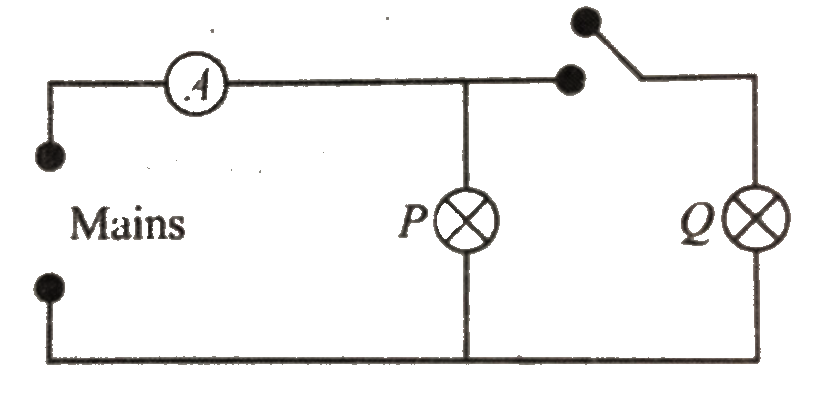
View SolutionA potentiometer is connected across `A `and `B` and a balance is obtained at `64.0 cm`. When the potentiometer lead at `B` is moved to `C`, a balance is found at `8.0 cm`. If the potentiometer is now connected across `B` and `C`, a balanced will be found at

View SolutionIn the circuit shows in Fig. `6.41`, the reading of the ammeter is (assume internal resistance of the battery be to zero)
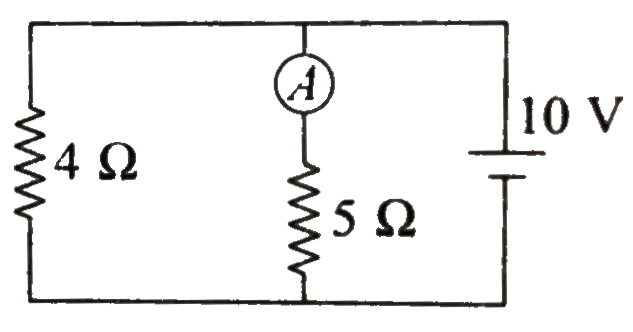
View SolutionIn the circuit shows in Fig. `6.42`, resistors `X` and `Y`, each with resistance `R`, are connected to a `6 V` battery of negligible internal resistance. A voltmetre, also of resistance `R`, is connected across `Y`.
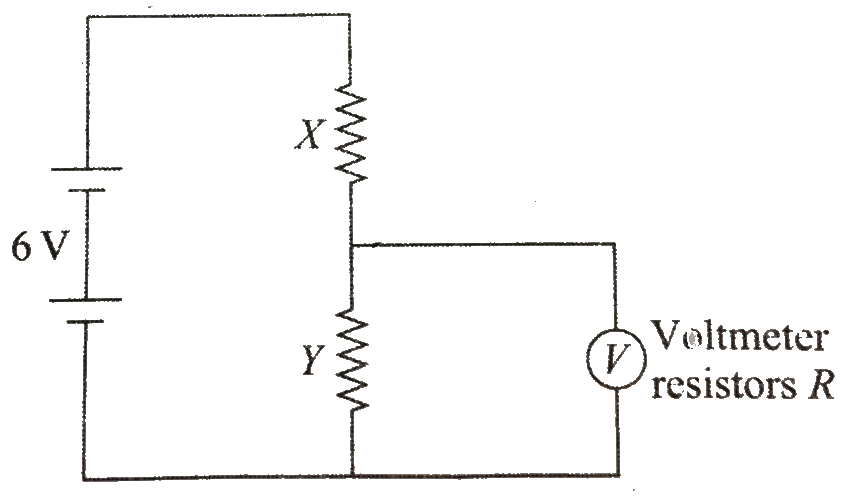
What is the reading of the voltmeter?
View SolutionIn the shows arrangement of a meter bridge, if `AC` corresponding to null deflection of galvanometer is x, what would be its value if the radius of the wire `AB` is doubled?
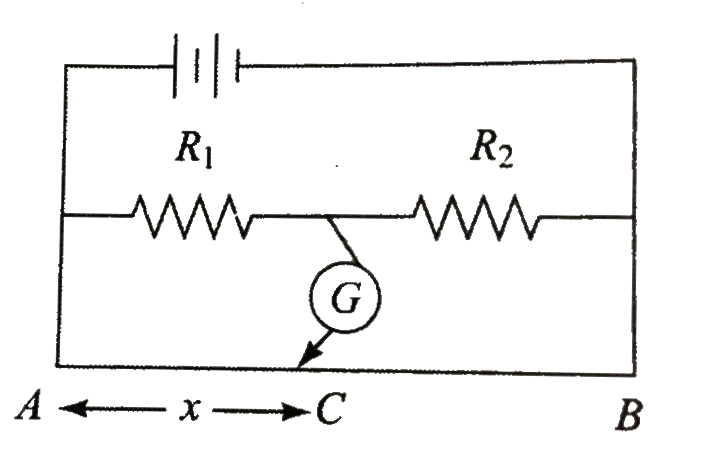
View SolutionThe length of a wire of a potentiometer is 100 cm, and the e.m.f. of its standard cell is E volt. It is employed to measure the e.m.f. of a battery whose internal resistance is `0.5 Omega`. If the balance point is obtained at I = 30 cm from the positive end, the e.m.f. of the battery is .
where i is the current in the potentiometer wire.
View SolutionIn a meter bridge experiment, the null point is obtained at `20 cm`from one end of the wire when resistance `X` is balanced against another resistance `Y`. If `X lt Y`, then where will be the new position of the null point from the same end, if one decides to balanced a resistance of `4X` against `Y`?
View SolutionIn the circuit, the galvanometer G shows zero deflection. If the batteries A and b have negligible internal resistance, the value of the resistor R will be -
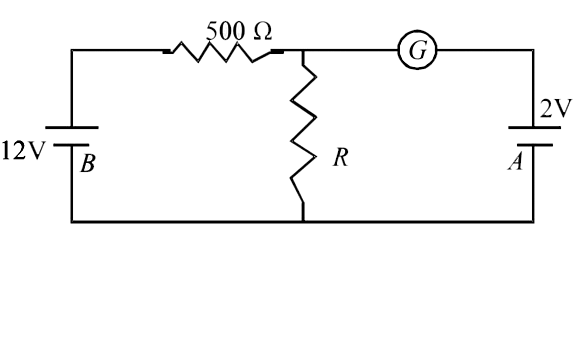
View SolutionIn a potentiometer experiment the balancing with a cell is at length 240 cm. On shunting the cell with a resistance of `2Omega`, the balancing length becomes 120 cm.The internal resistance of the cell is
View SolutionIf in the experiment of Wheatstone's bridge, the positions of cells and galvanometer are interchanged, then balance point will
View SolutionSensitivity of potentiometer can be increased by
View SolutionThe resistance of a galvanometer is `10 Omega`. It gives full-scale deflections when `1 mA` current is passed. The resistance connected in series for converting it into a voltmeter of `2.5 V` will be
View SolutionA milliammeter of range `10 mA` has a coli of resistance `1 Omega`. To use it as an ammeter of range `1 A`, the required shunt must have a resistance of
View SolutionTwo cells of emfs `E_(1)` and `(E_(2) (E_(1) gt E_(2))` are connected as shows in Fig. `6.45`.

When a potentiometer is connected between `A` and `B`, the balancing length of the potentiometer wire is `300 cm`. On connecting the same potentiometer between `A` and `C`, the balancing length is `100 cm`. The ratio `E_(1)//E_(2)` is
View SolutionFigure `6.46`, shows a wheatstone net, with `P = 1000 Omega`,`Q = 10.0 Omega`,`R`(unknows), `S` variable and near `150 Omeag` for balance. If the connections across `A,C` and `B,D` are interchanged, the error range in `R determination would
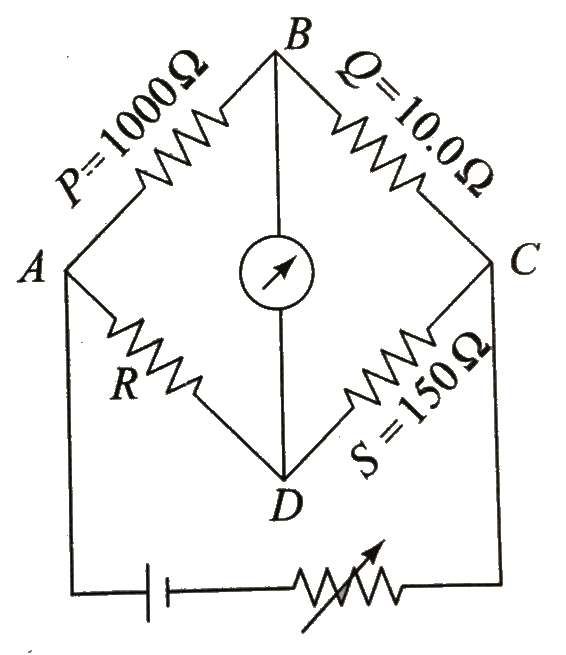
View SolutionAn ideal ammeter (zero resistance) and an idel voltmeter (infinite resistance) are connect as shows in Fig. `6.47`. The ammeter and the voltmeter readings are
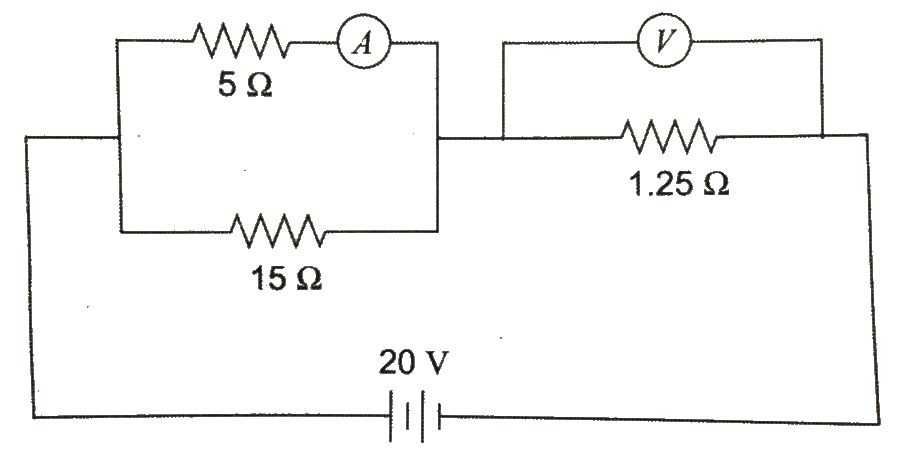
View SolutionA constant `60 V` dc supply is connected across two resistors of resistance `400 k Omega` and `200 k Omega`. What is the reading of the voltmeter, also of resistance `200 k Omega`, when connected across the second resistor as shows in Fig. `6.48`?
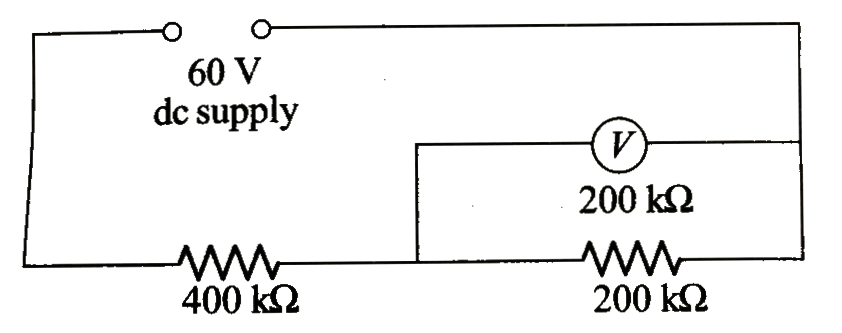
View SolutionFigure `6.49` shows a circuit that may be used to compare the resistance `R` of an ubknown resistor with a `100 Omega` standard. The distance `l` from one end of the potentiometer slider wire to the balance point are `400 mm` and `588 mm` when `X` is connected to `Y` and `Z`, respectively. The length of the slide wire is `1.00 m`. What is the value of resistance `R`?
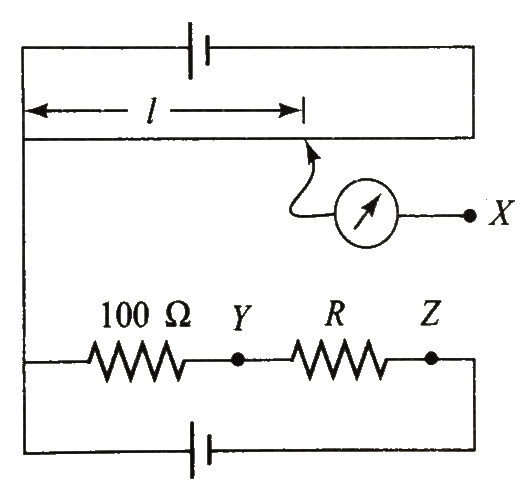
View SolutionIn the circuit shown in Fig. `6.50`, an idel ammeter and an ideal voltmeter are used. Whan the key is open, the voltmeter reads `1.53 V`. When the key is closed, the ammeter reads `1.0 A` and the voltmeter reads `1.03 V`. The resistance `R` is

View SolutionIn which of the follwing arrangements of resistors does the meter `M`, which has a resistance of `2 Omega`, give the largest reading when the same potential difference is appliced between points `P` and `Q`?
View SolutionFigure `6.51` shows a simple a potentiometer circuit for measuring a small emf produced by a thermocouple.
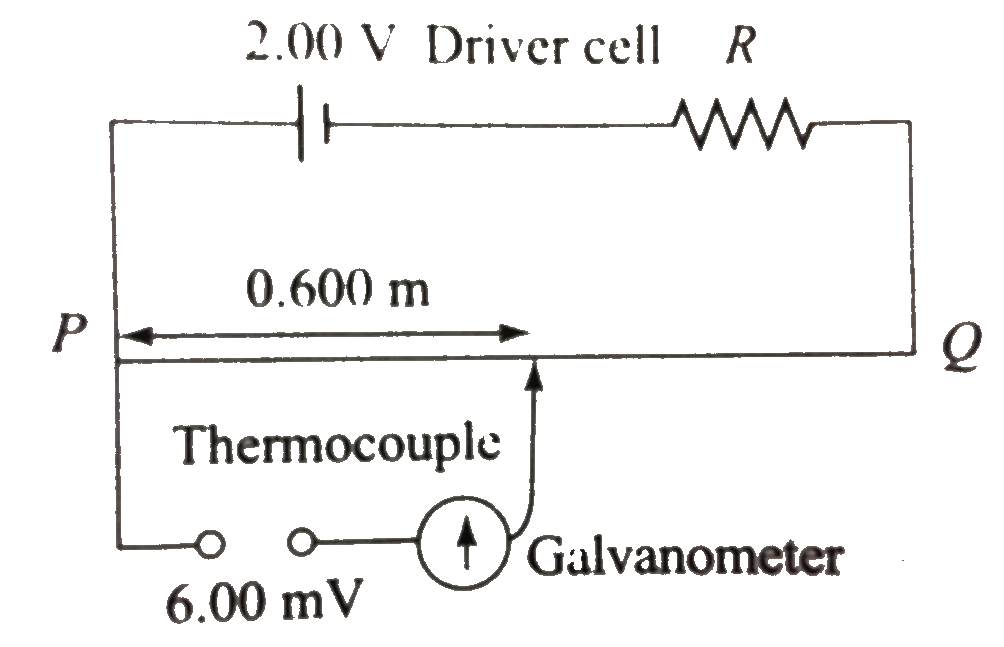
The meter wire `PQ` has a resistance of `5 Omega`, and the driver cell has an emf of `2.00 V`. If a balance point is obtained `0.600 m` along `PQ` when measuring an emf of `6.00 mV`,
what is the value of resistance `R`?
View SolutionFigure`6.52` shows a balanced wheatstone net. Now, it is disturbed by changing `P` to `11 Omega`. Which of the following steps will not bring the bridge to balance again?

View SolutionIn an experiment to measure the internal resistance of a cell by a potentiometer, it is found that the balance point is at a length of `2 m` when the cell is shunted by a `5 Omega` resistance and is at a length of `3 m` when the cell is shunted by a `10 Omega` resistance, the internal resistance of the cell is then
View SolutionWhen an ammeter of negligible internal resistance is inserted in series with circuit, it reads `1 A`. When a voltmeter of very large resistance is connected across `R_(1)`, it reads `3 V`. But when the points `A` and `B` are short-circuited by a conducting wire, then the voltmetre measures `10.5 V` across the battery. The internal resistance of the battery is equal to
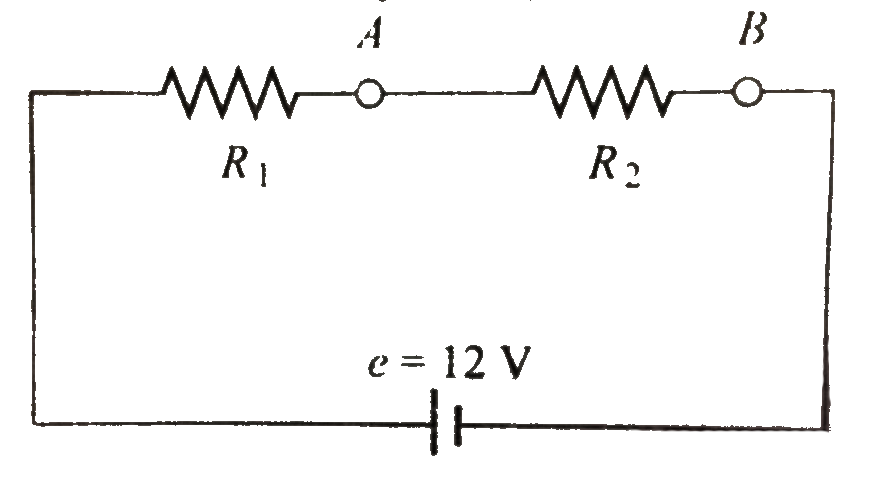
View SolutionAn `80 Omega` galvanometer deflects full-scale for a potential of `20 mV`. A voltmeter deflcting full-scale of `5 V` is to be made using this galvanometer. We must connect
View SolutionA voltmeter having a resistance of `1800 Omega` is employed to measure the potential difference across `200 Omega` resistance, which is connected, to dc power supply of `50 V` and internal resistance `20 Omega`. What is the approximate percentage change in the potential difference across `200 Omega` resistance as aresult of connecting the voltmeter across it?
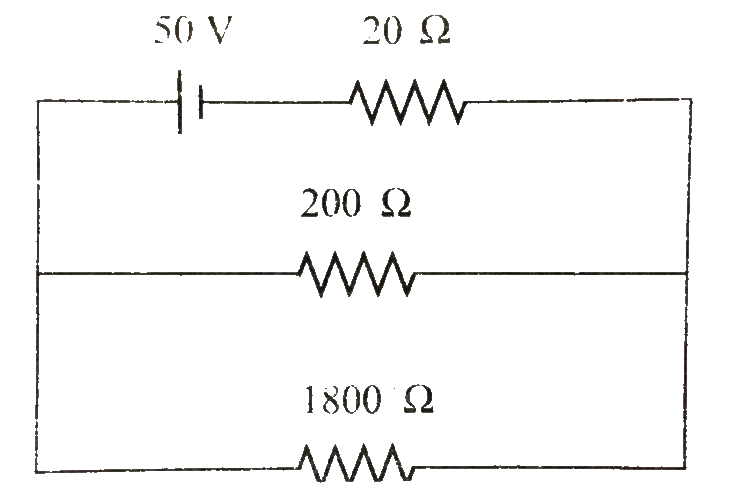
View SolutionIn the given circuit, the voltmeter and the electric cell are ideal. Find the reading of the voltmetre

View SolutionThe emf of the driver cell of a potentiometer is `2 V`, and its internal resistance is negligible. The length of the potentiometer wire is `100 cm`, and resistance is `5 omega`. How much resistance is to be connected in series with the potentiometer wire to have a potential gradient of `0.05 m V cm^(-1)`?
View SolutionIn the above question, if the balancing length for a cell of emf `E` is `60 cm`, the value of `E` will be
View Solution`A, B` and `C` are voltmeters of resistances `R, 1.5R` and `3R` respectively. When some potential difference is applied between `x` and `y` the voltmeter readings are `V_A, V`_B`and `V_C,` then
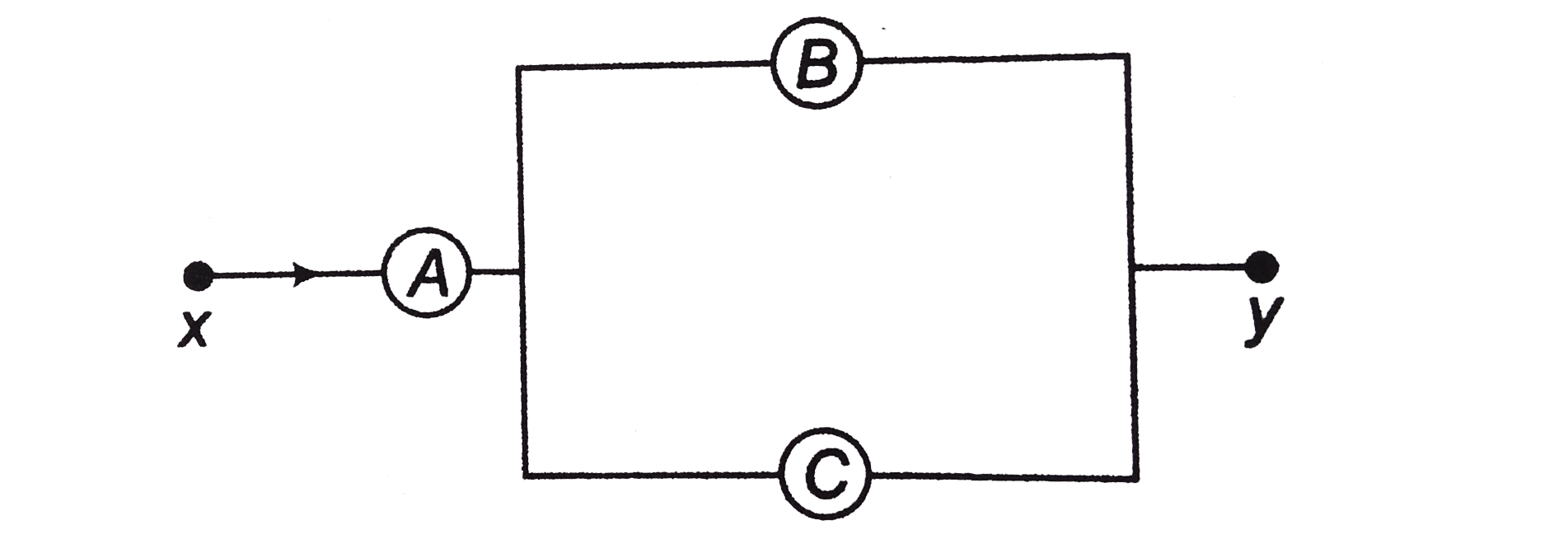
View SolutionA milliammeter of range `10 mA` and resistance `9 Omega` is joined in a circuit as shown. The metre gives full-scale deflection for curretn `I` when `A` and `B` are used as its terminals, i.e., current enters at `A` and leaves at `B` (`C` is left isolated). The value if `I` is
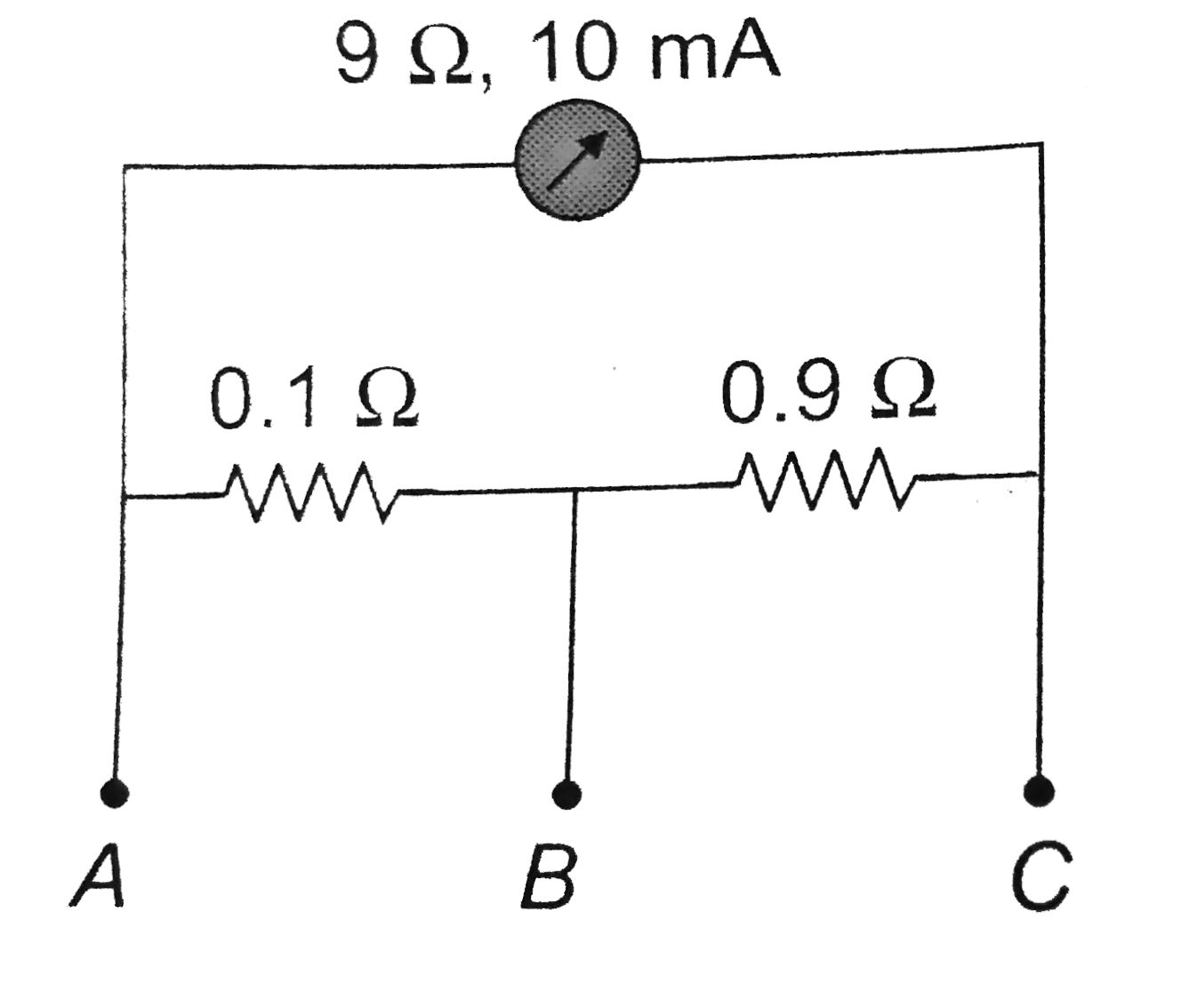
View SolutionA candidate connects a moving coil voltmeter `V`, a moving coil ammeter `A` and a resistance `R` as shown in figure. If the voltmeter reads `24 V` and the ammeter reads `4 A`, R is
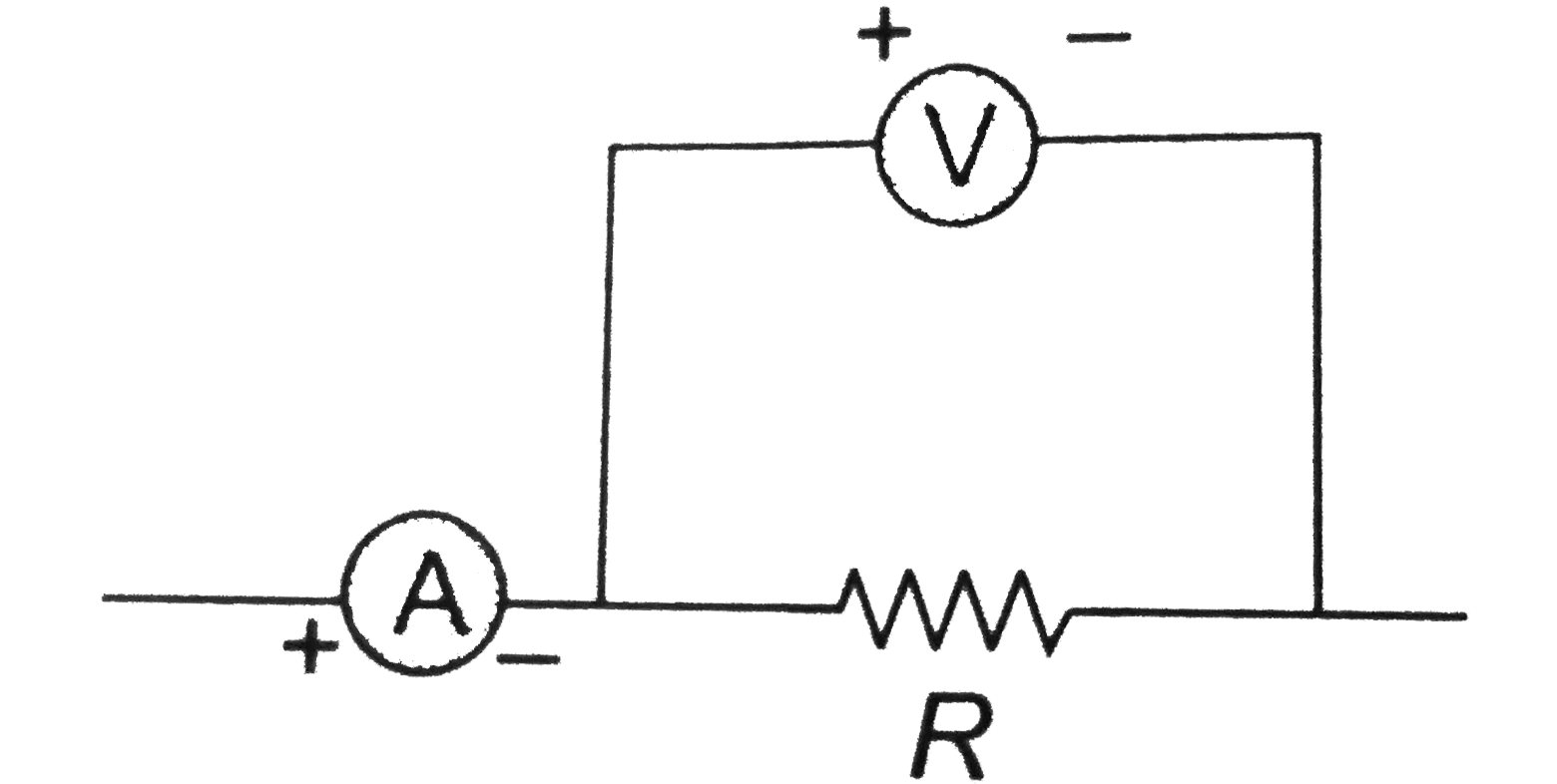
View SolutionIf a shunt `1//10` of the coil resistance is applied to a moving coil galvanometer, its sensitivity becomes
View SolutionIn Fig.`6.59`, when an ideal voltmetre is connected across `4000 Omega` resistance, it reads `30 V`. If the voltmeter is connected across `3000 Omega` resistance, it will read
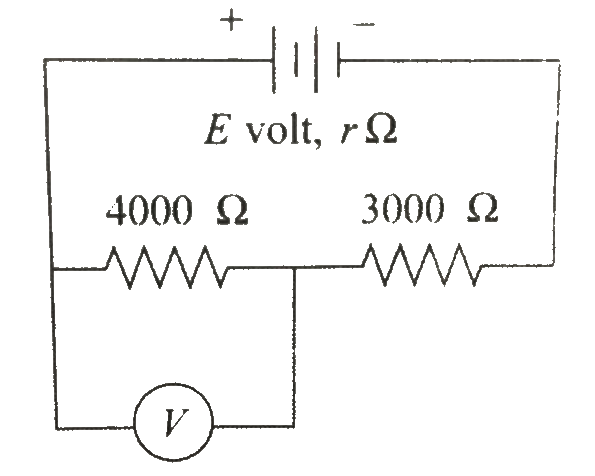
View SolutionA voltmeter has a resistance `G` and range `V`. Calculate the resistance to be used in series with it to extend its range to `nV`.
View SolutionA galvanometer has a resistance of `3663Omega`. A shunt `S` is connected across it such that (`1//34`) of the total current passes through the galvanometer. Then the value of the shunt is
View SolutionThe combined resistance of the shunt and the galvanometer is
View SolutionIn `Q.36`, the external resistance that must be connected is series with the main circuit so that the total current in the main circuit remains unaltered even when the galvanometer is shunted is
View SolutionTwo moving coil galvanometers `1` and `2` are with identical field magnets and suspension torque constants, but with coil of different number of turns `N_(1)` and `N_(2)`, area per turn `A_(1)` and `A_(2)`, and resistance `R_(1)` and `R_(2)`. When they are connected in series in the same circuit, they show deflections `theta_(1)` and `theta_(2)`. then `theta_(1)//theta_(2)` is
View SolutionAn ammetre is obtained by shunting a `30 Omega` galvanometer with a `30 Omega` resistance. What additional shunt should be connected across it to double the range ?
View SolutionThree voltmeters are connected as shown.

A potential difference has been applied between `A` and `B`. On closing the swich `S`, readings of voltmeters?
View SolutionA constant potential difference is applied across a resistance. Consider variation of resistance with temperature. Which graph represents best the variation of power produced in resistance versus resistance?
View SolutionIn Fig.`6.61` the voltmetre and ammeter shows are ideal. Then voltmeter and ammeter readings, respectively, are
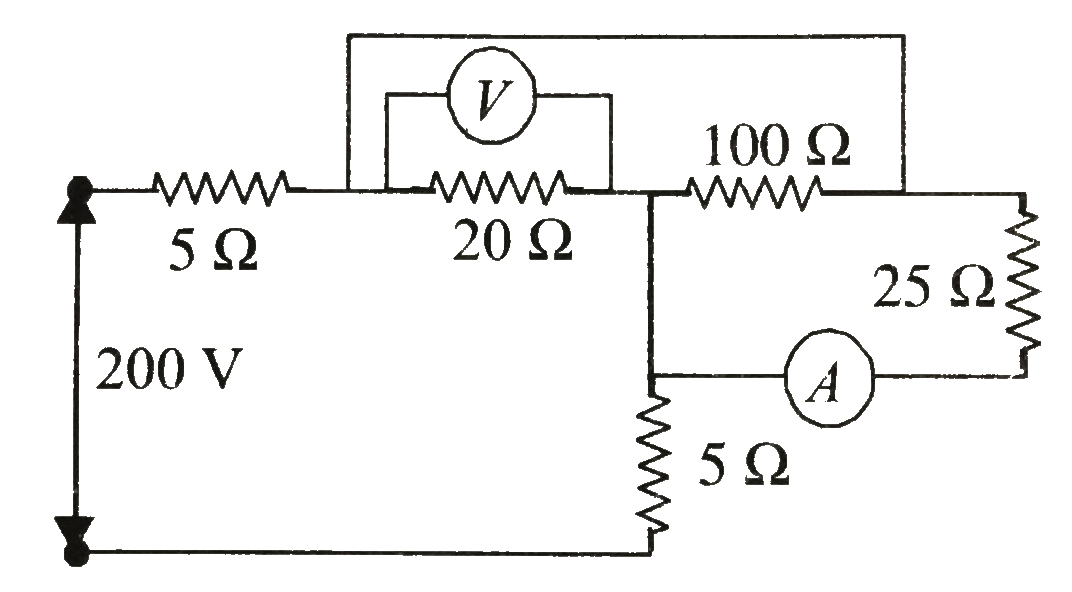
View SolutionA potentiometer arrangement is shows in Fig. `6.62`. The driver cell has emf `e` and internal resistance `r`. The resistance of potentiometer wire `AB` is `R.F` is the cell of emf `e//3` and internal resistance `r//3`. Balance point `(J)` can be obtained for all finite value of
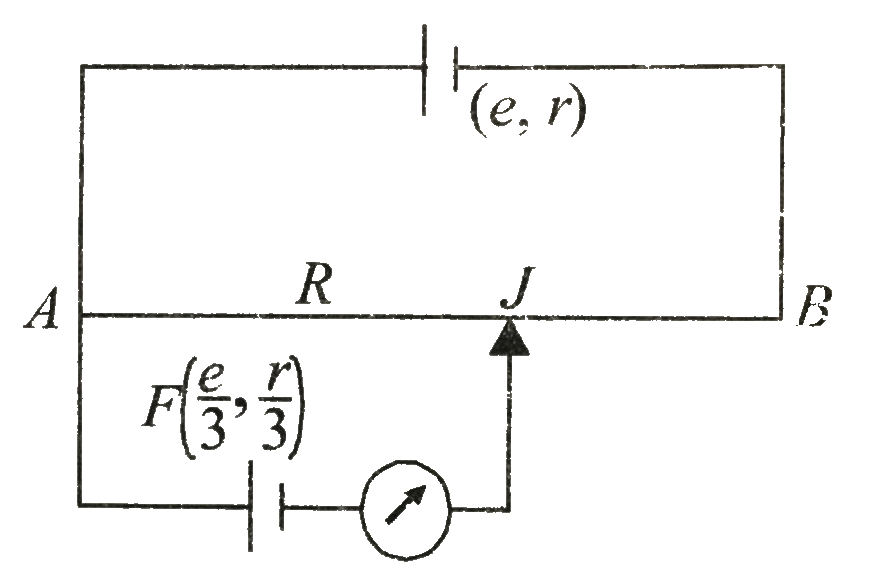
View Solution`50 Omega` and `100 Omega` resistors are connected in series. This connection is connected with a battery of 24 volts. When a voltmeter of `100 Omega` resistance is connected across `100 Omega` resistor, then the reading of the voltmeter will be
View SolutionAn ammeter gives full scale deflection when current of 1.0 A is passed in it. To convert it into 10 A range ammeter, the ratio of its resistance and the shunt resistance will be
View Solution100mA current gives a full scale deflection in a galvanometer of `2Omega` resistance. The resistance connected with the galvanometer to convert it into a voltmeter to measure 5V is
View SolutionWhen a `12 Omega` resistor is connected with a moving coil galvanometer, then its deflection reduces form 50 divions to 10 divisions. The ressitance of the galvanometer is
View SolutionThe resistance of a galvanometer is 90 ohm s. If only 10 percent of the main current may flow through the galvanometer, in which way and of what value, a resistor is to be used
View SolutionIn the diagram shown, the reading of voltmeter is 20 V and that of ammeter is 4 A . The value of R should be (Consider given ammeter and voltmeter are not ideal)
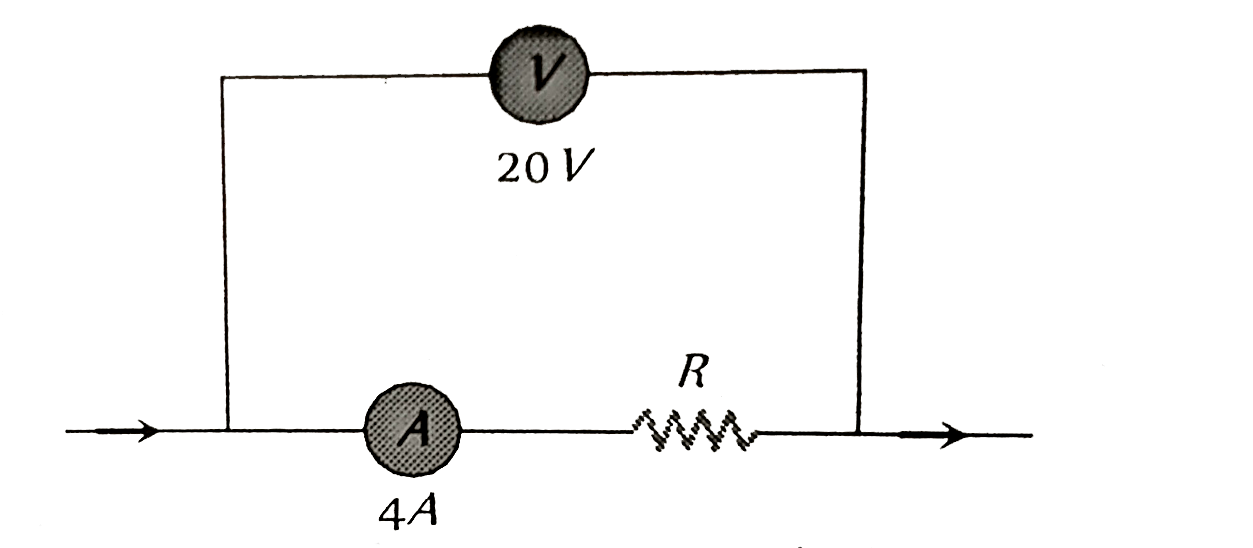
View SolutionA voltmeter having a resistance of 998 ohms is connected to a cell of e.m.f. 2 volt and internal resistance 2 ohm. The error in the measurment of e.m.f. will be
View SolutionA `100 V` voltmeter of internal resistance `20 k Omega` in series with a high resistance `R` is connected to a `110 V` line. The voltmeter reads `5 V`, the value of `R` is
View SolutionIn the adjoining circuit, the e.m.f. of the cell is 2 volt and the internal resistance is negligible. The resistance of the voltmeter is `80 ohm`. The reading of the voltmeter will be
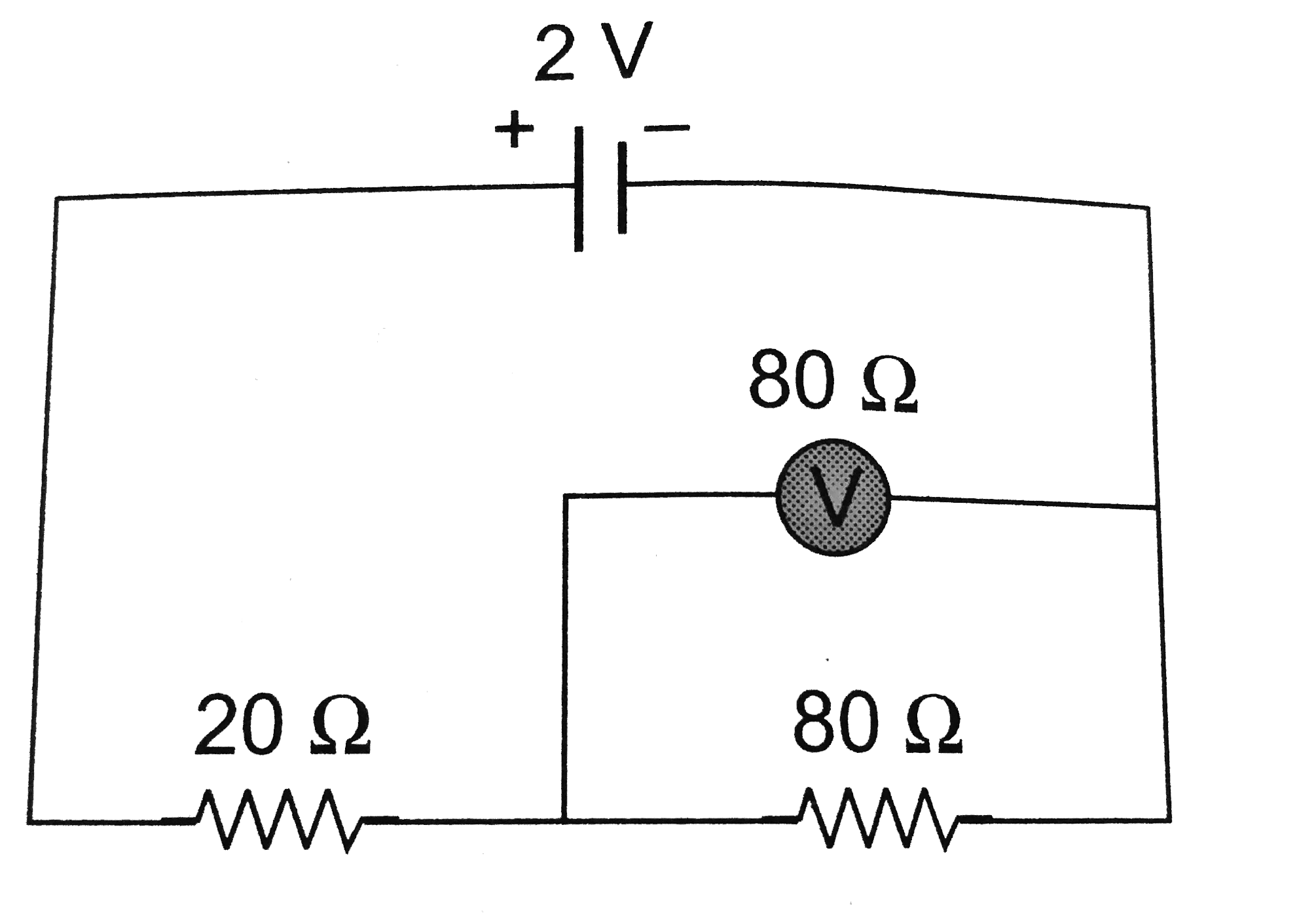
View SolutionA galvanometer has 30 divisions and a sensitivity `16 mu A //"div"`. It can be converted into a voltmeter to read `3 V` by connecting
View SolutionVoltmeters `V_(1)` and `V_(2)` are connected in series across a `D.C.` line `V_(1)` reads 80 volts and has a per volt resistance of `200 ohms`, `V_(2)` has a total resistance of 32 kilo ohms.
The line voltage is
View SolutionA voltmeter has a range `O - V` with a series resistance `R`. With a series resistance `2R`, the range is `O - V`. The correct relation between `V` and `V'`is
View SolutionA moving coil galvanometer is converted into an ammeter reads upto `0.03 A` by connecting a shunt of resistance `4r` across it and ammeter reads up `0.06 A`, when a shunt of resistance `r` is used. What is the maximum current which can be sent through this galvanometer if no shunt is used ?
View SolutionIn the circuit shown, the galvanometer shows zero current. The value of resistance R is :
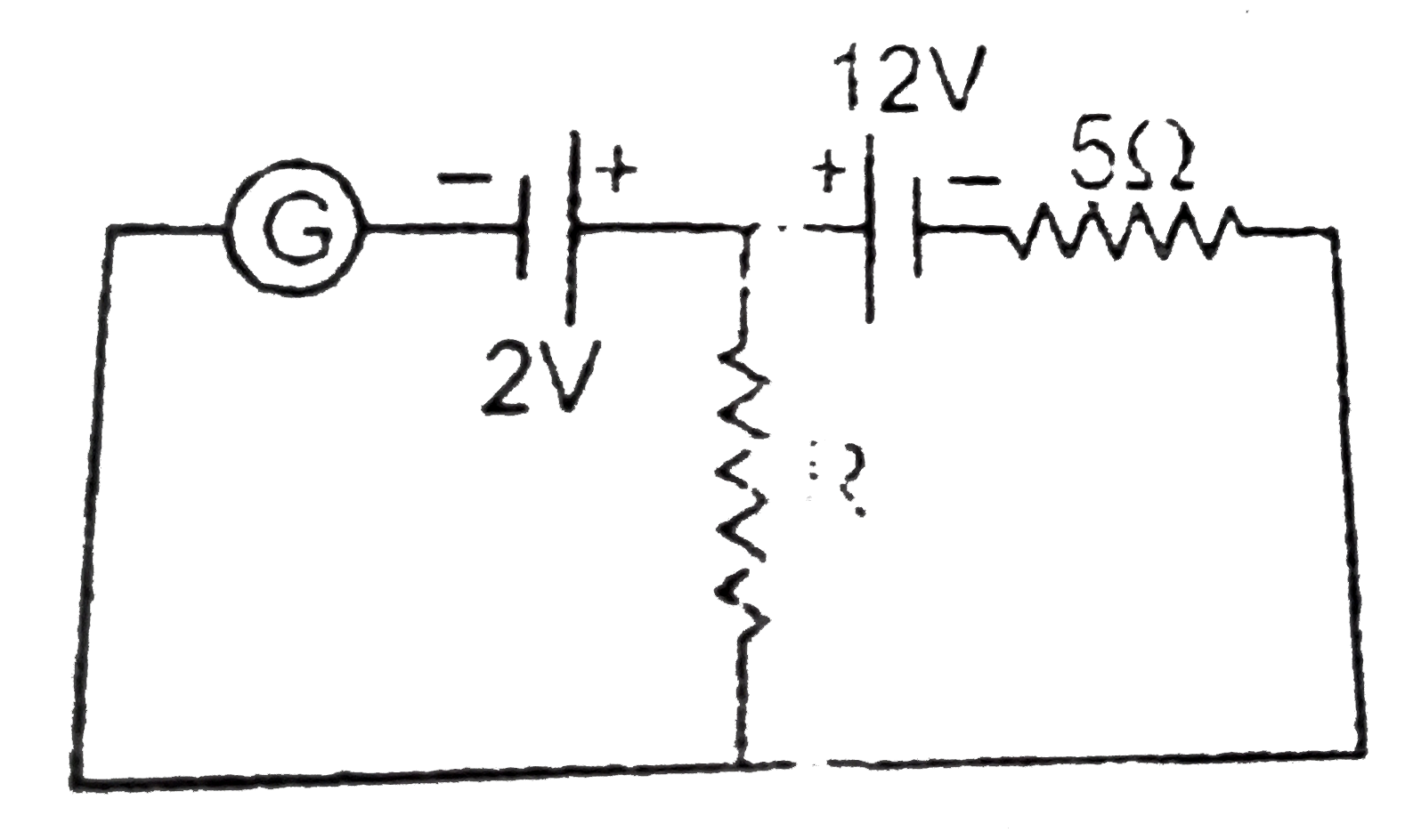
View SolutionWhether the switch K is open or closed, the reading of galvanometer is the same. If I denotes the current then :
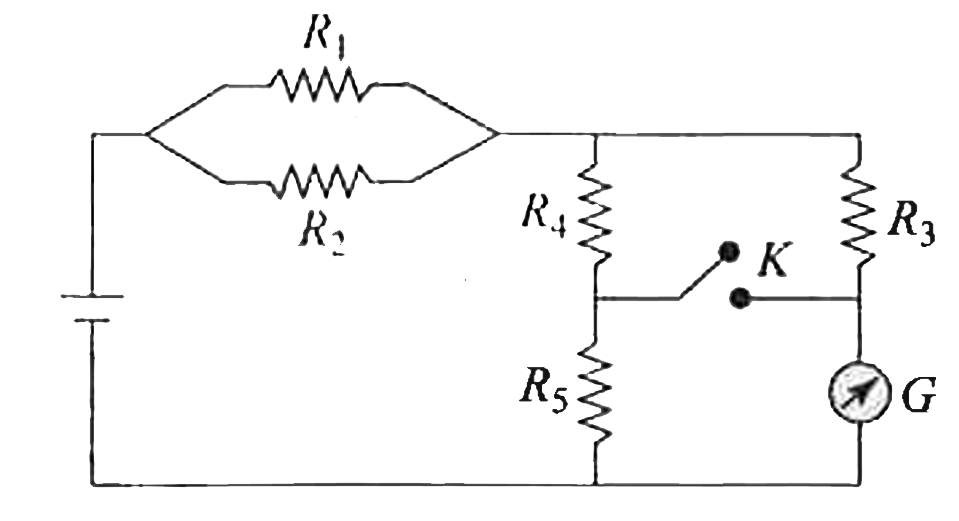
View SolutionThe measurement of voltmeter in the following circuit is
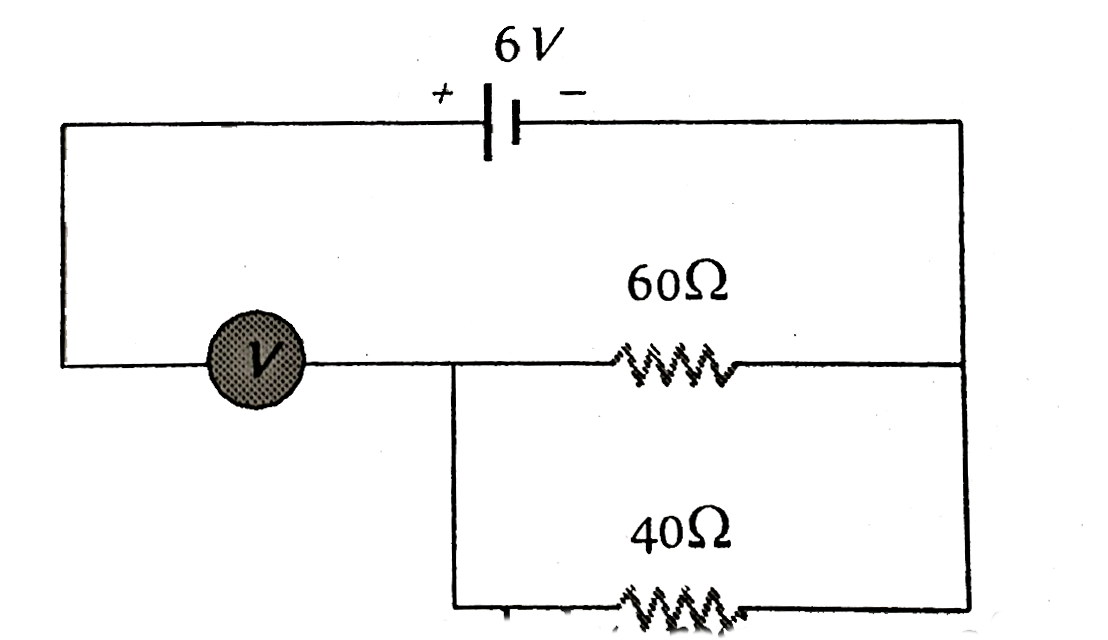
View SolutionAn ammeter and a voltmeter of resistance `R` connected in seires to an electric cell of negligible internal resistance. Their readings are `A` and `V` respecitvely. If another resistance `R` is connected in parallel with the voltmeter
View SolutionThe potential difference across the `100 Omega` resistance in the following circuit is measured by a voltmeter of `900 Omega` resistance. The percentage error made in reading the potential difference is
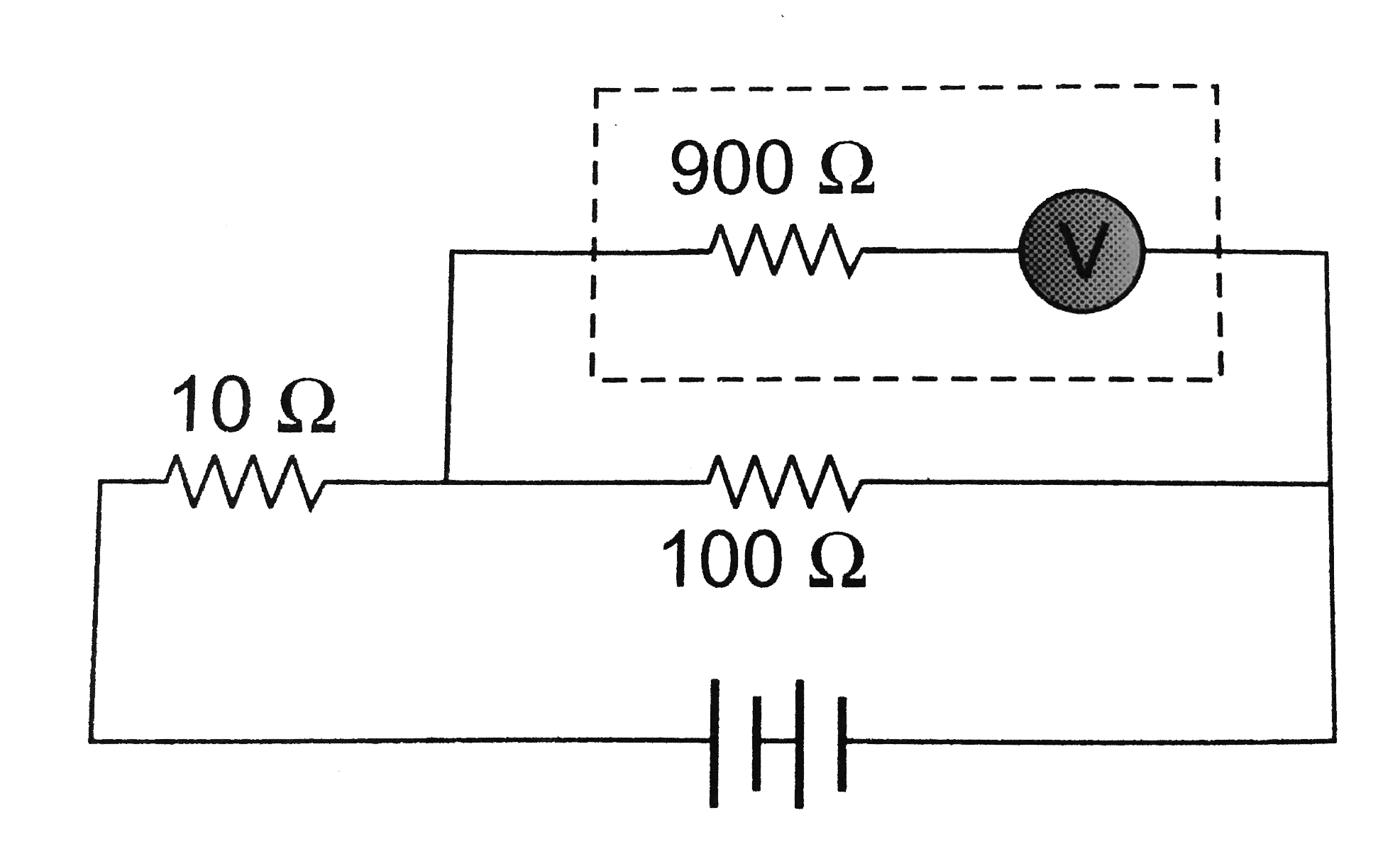
View SolutionTwo resistance of `400 Omega` and `800 Omega` are connected in series with 6 volt battery of negligible internal resistance. A voltmeter of resistance `10,000 Omega` is used to measure the potential difference across `400 Omega`. The error in measurement of potential difference in volts approximatley is
View SolutionA galvanometer, having a resistance of `50 Omega` gives a full scale deflection for a current of `0.05 A`. The length in meter of a resistance wire of area of cross-section `2.97 xx 10^(-2) cm^(2)` that can be used to convert the galvanometer into an ammeter which can read a maximum of `5 A` current is (Specific resistance of the wire `5 xx 10^(-7) omega m`)
View SolutionWhat is the reading of voltmeter in the following figure ?
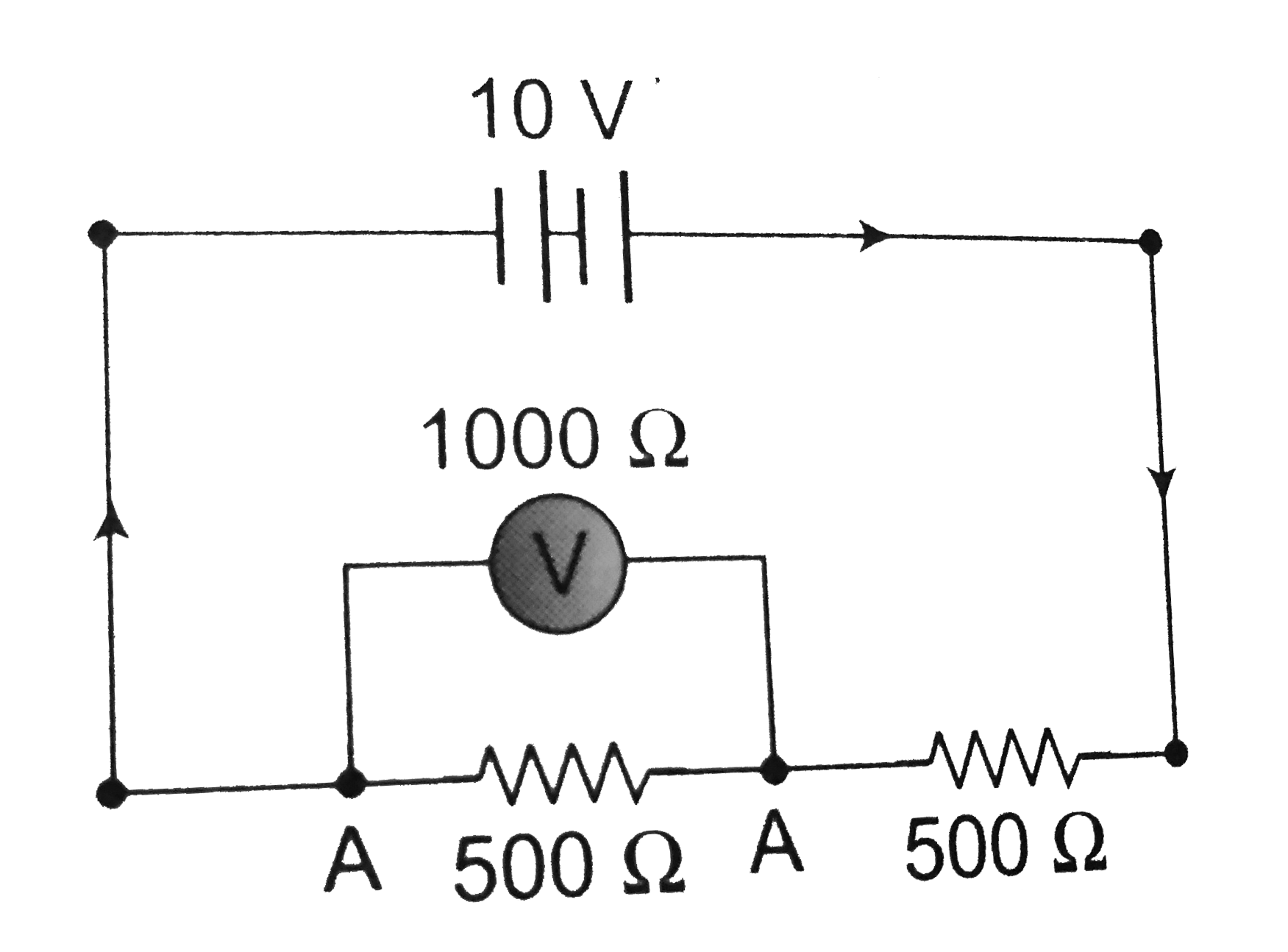
View SolutionIf resistance of voltmeter is `10000 Omega` and resistance of ammeter is `2Omega` then find R when voltmeter reads 12 V and ammeter reads 0.1 A
View SolutionIn the circuit shown in figure, reading of voltmeter is `V_1` when only `S_1` is closed, reading of voltmeter is `V_2` when only `S_2` is closed, and reading of voltmeter is `V_3` when both `S_1 and S_2` are closed. Then .
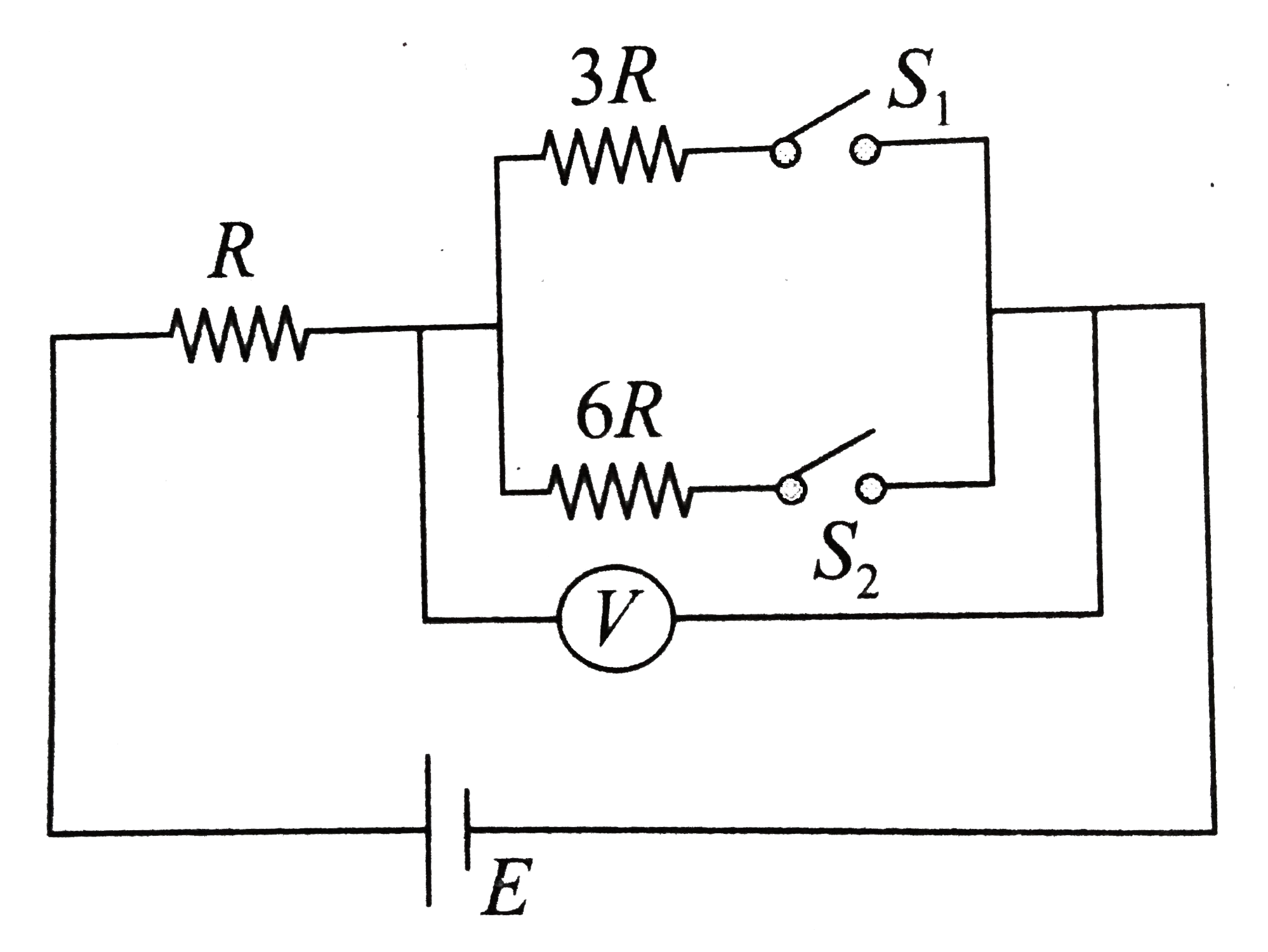
View SolutionA moving coil galvanometer has 150 equal divisions. Its current sensitivity is 10-divisions per milliampere and voltage sensitivity is 2 divisions per millivolt. In order that each division reads 1 volt, the resistance in ohms needed to be connected in series with the coil will be -
View SolutionThe graph which represents the relation between the total resistance `R` of a multi range moving coil voltmeter and its full scale deflection
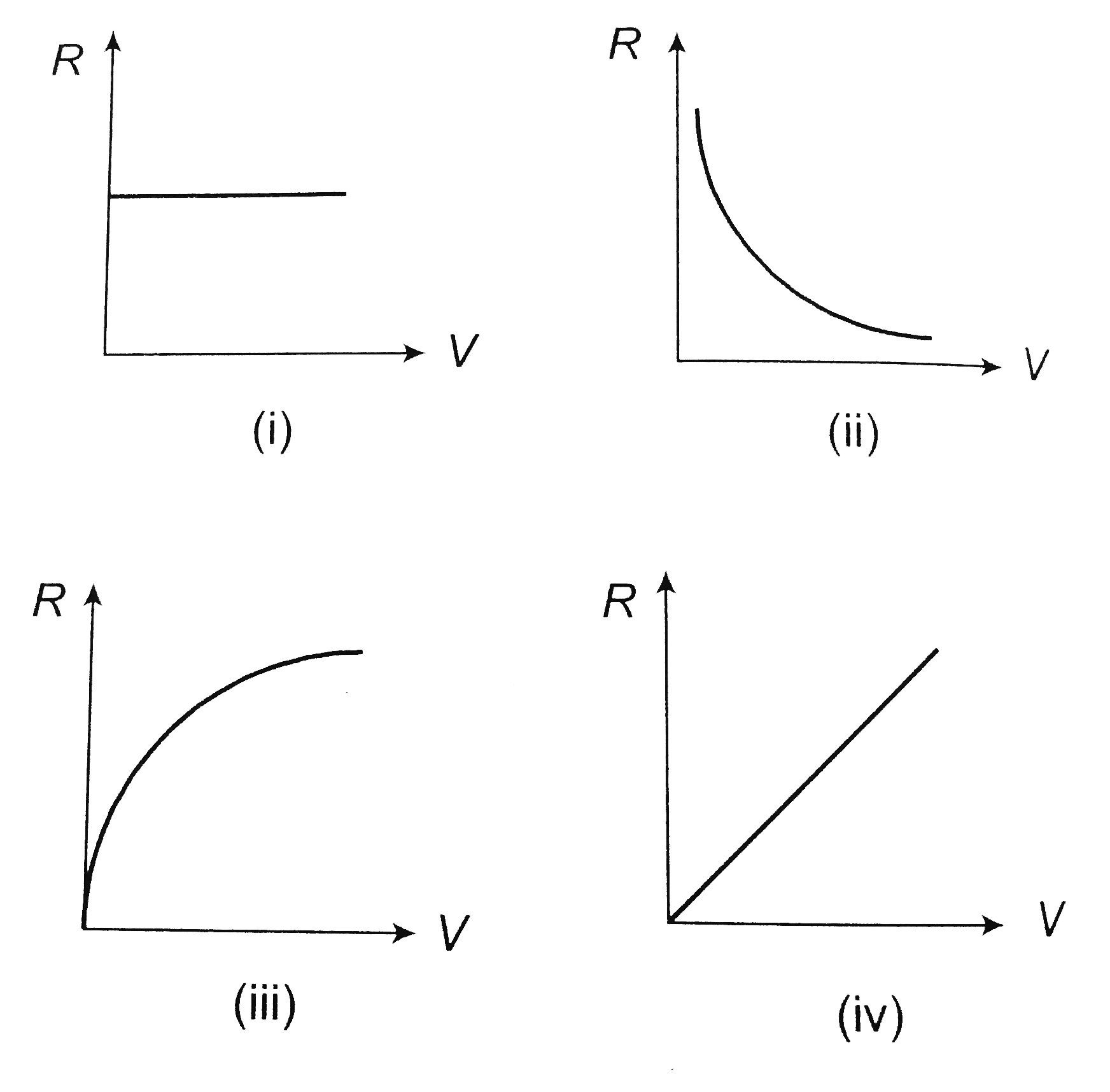
View SolutionThe ammeter has range 1 ampere without shunt. The range can be varied by using different shunt resistance. The graph between shunt resistance and range will have the nature
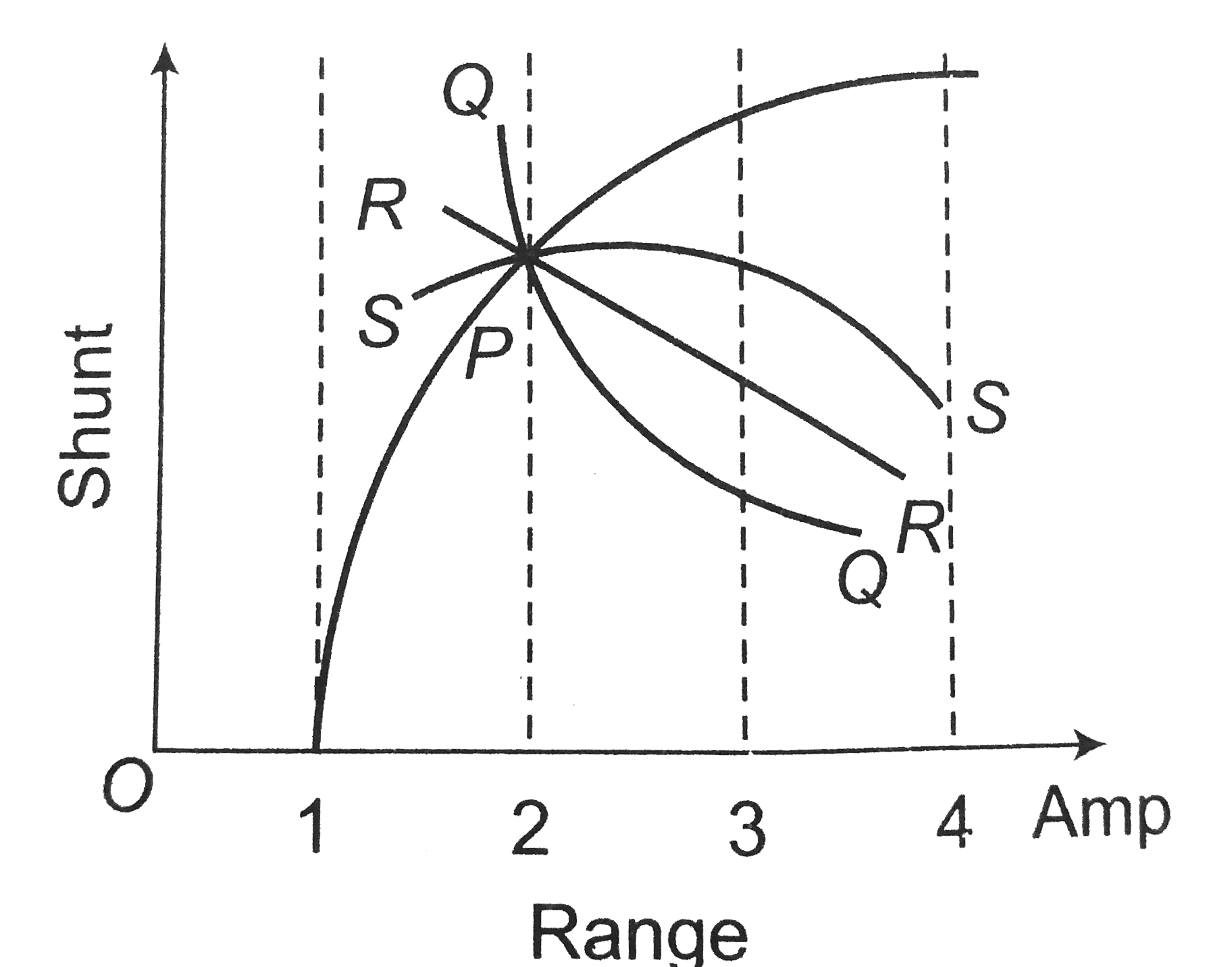
View SolutionIn the circuit shown here, the readings of the ammeter and voltmeter are
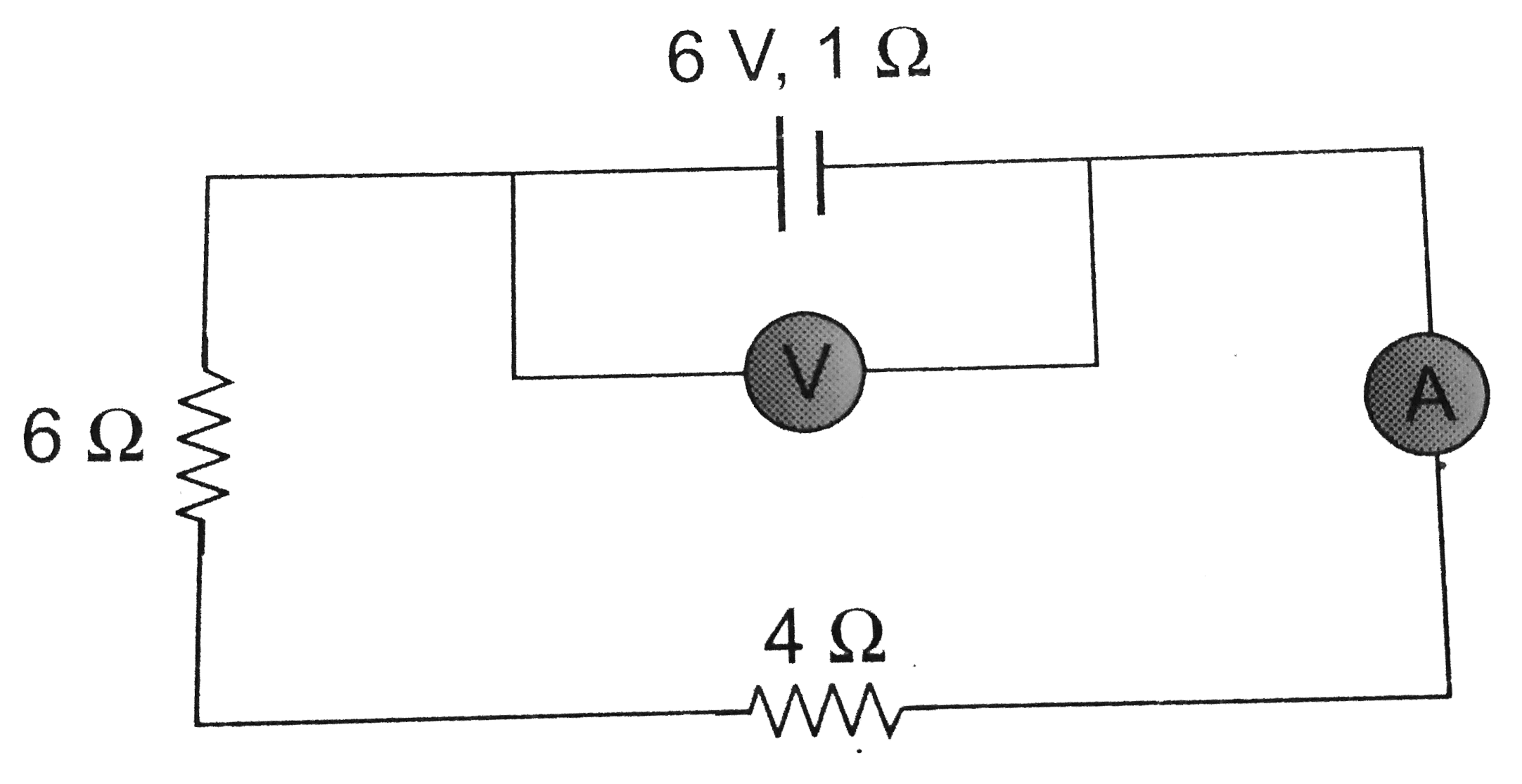
View SolutionThe reading of the ideal voltmeter in the adjoining diagram will be
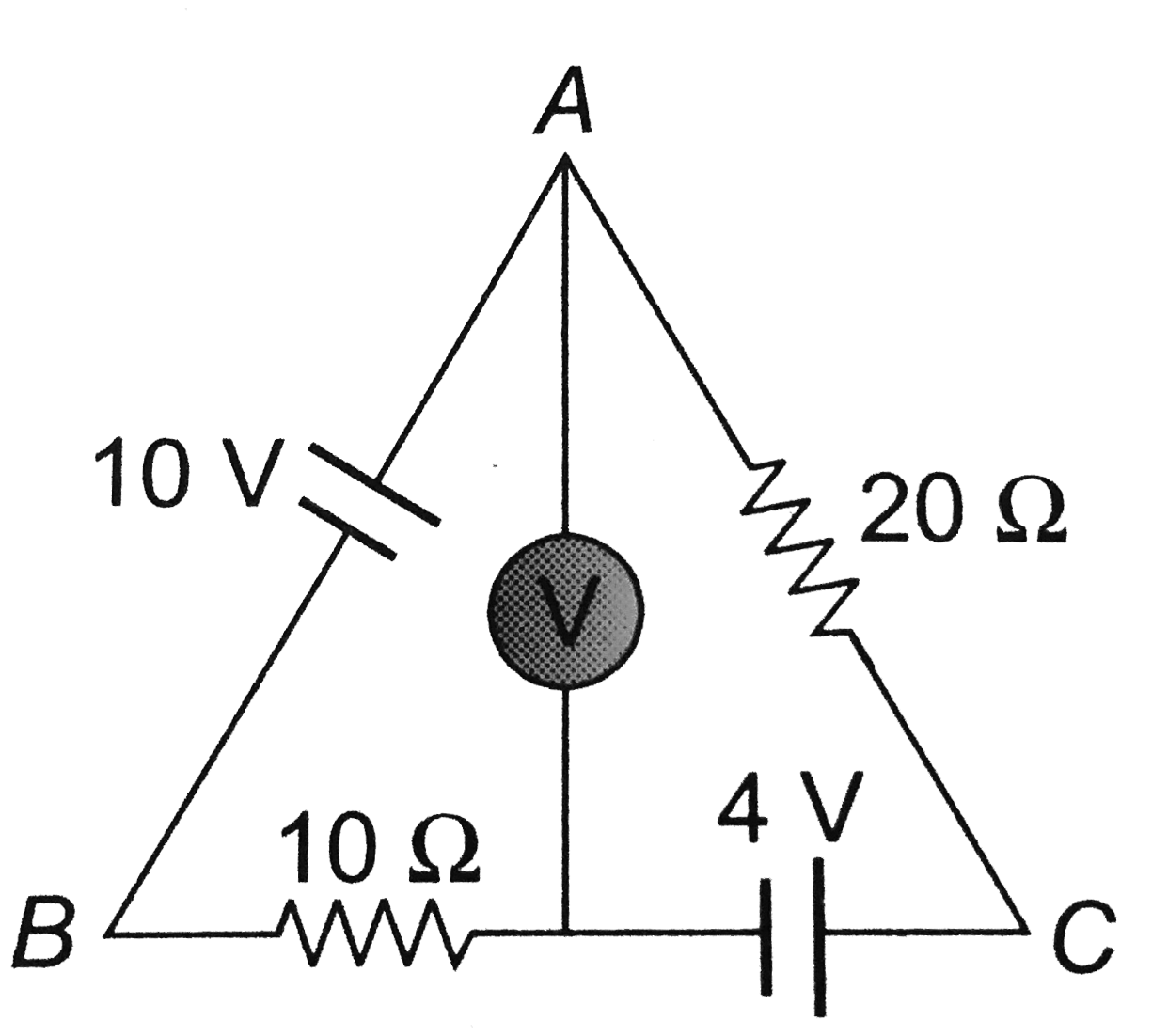
View SolutionA moving coil galvanometer has 150 equal divisions. Its current sensitivity is 10-divisions per milliampere and voltage sensitivity is 2 divisions per millivolt. In order that each division reads 1 volt, the resistance in ohms needed to be connected in series with the coil will be -
View SolutionA potentiometer is an ideal device of measuring potential difference because
View SolutionA cell of itnernal resitance `1.5 Omega` and of e.m.f. `1.5` volt balances `500 cm` on a potentiomter wire. If a wirr of 15 `Omega` is connected between the balance point and the cell, then tha balance point will shift
View SolutionFor comparing the e.m.f.'s of two cells with a potentiometer, a standard cell is used to develop a potential gradient along the wires. Which of the following possibilities would make the experiment unsuccessful gt
View SolutionThe circuit shown here is used to compare the e.m.f. of the two cells `E_(2) (E)_(1) gt E_(2)`. The null point is at `C` when the galvanometer is connected to `E_(1)`. When the galvanometer is connected to `E_(2)`, the null point will be
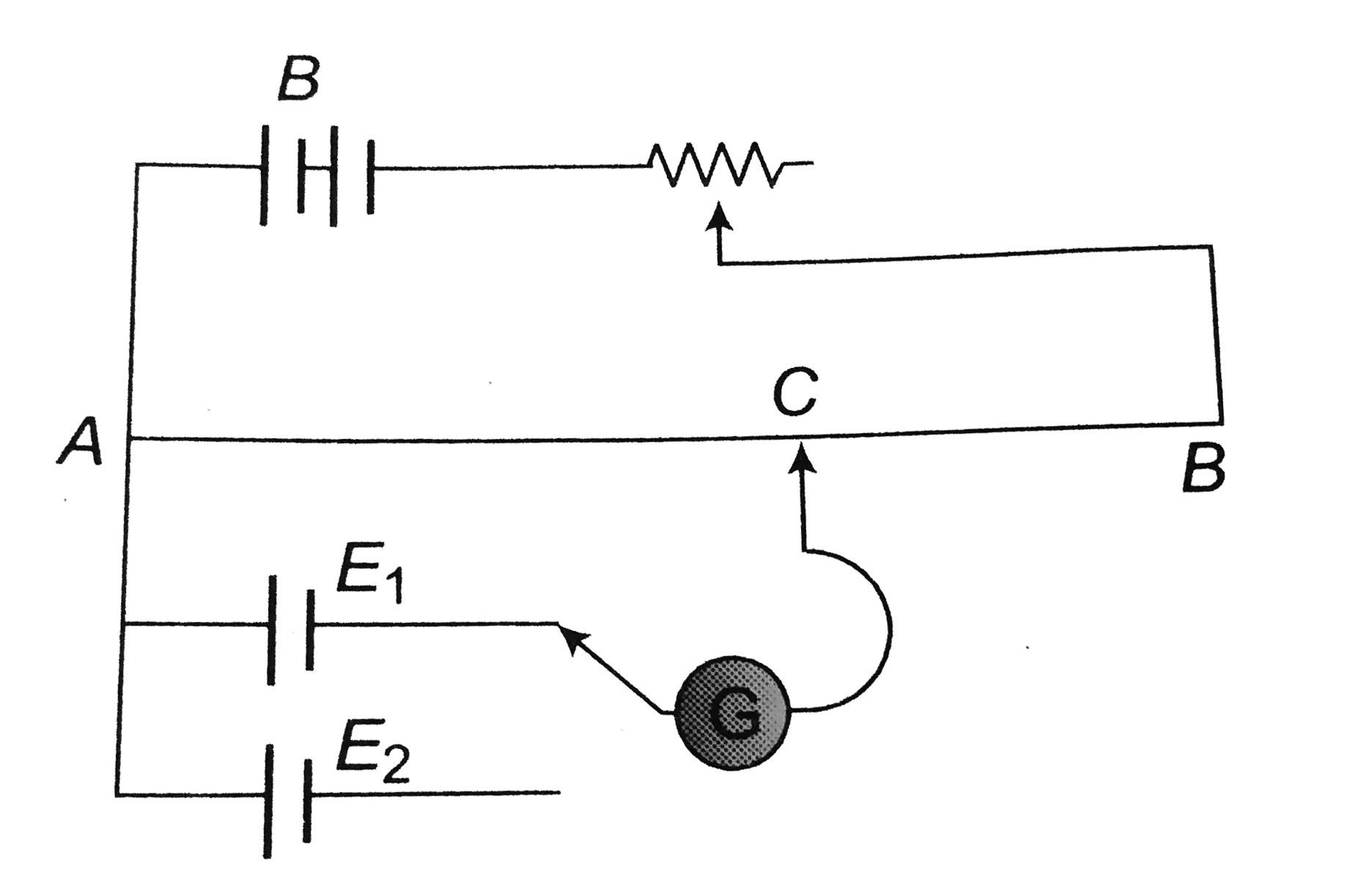
View SolutionA resistance of `4 Omega` and a wire of length 5 meters and resistance `5 Omega` are joined in series and connected to a cell of e.m.f. `10 V` and internal resistance `1 Omega`. A parallel combination of two identical cells is balanced across `300 cm` of wire. The e.m.f. `E` of each cell is
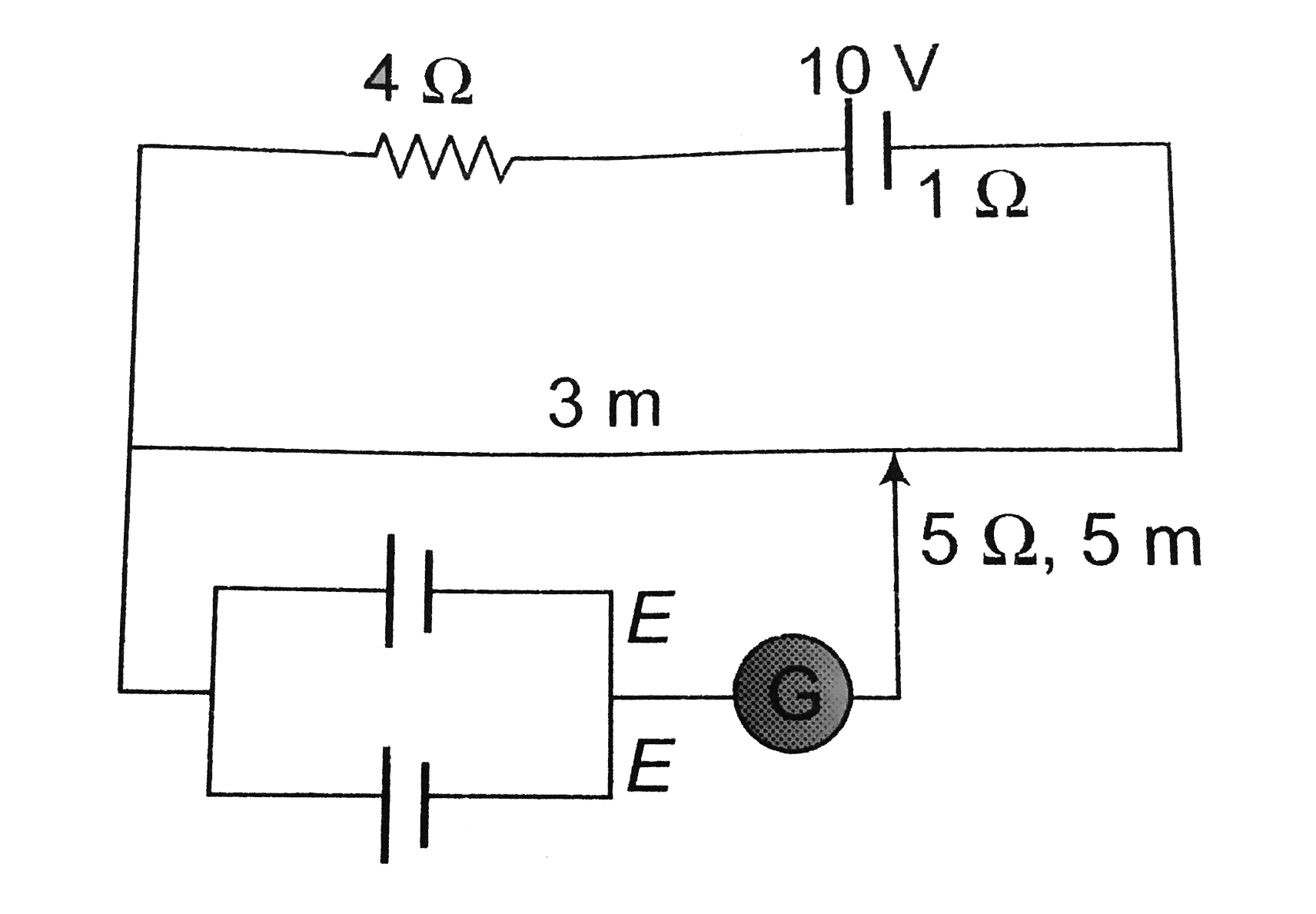
View SolutionThe length of a wire of a potentiometer is 100 cm, and the e.m.f. of its standard cell is E volt. It is employed to measure the e.m.f. of a battery whose internal resistance is `0.5 Omega`. If the balance point is obtained at I = 30 cm from the positive end, the e.m.f. of the battery is .
where i is the current in the potentiometer wire.
View SolutionPotentiometer wire of length `1 m` is connected in series with `490 Omega` resistance and `2 V` battery. If `0.2 mV/cm` is the potential gradient, then resistance of the potentiameter wire is approximately
View SolutionFigure `6.51` shows a simple a potentiometer circuit for measuring a small emf produced by a thermocouple.

The meter wire `PQ` has a resistance of `5 Omega`, and the driver cell has an emf of `2.00 V`. If a balance point is obtained `0.600 m` along `PQ` when measuring an emf of `6.00 mV`,
what is the value of resistance `R`?
View SolutionTwo cells of emfs approximately 5V and 10V are to be accurately compared using a poteniometer of length 400 cm.
View SolutionIn meter brigde of Wheatstone bridge for measurment of resistance, the known and the unknown resistance are interchanged. The error so removed is
View SolutionIn Wheatstone's bridge `P = 9 ohm`, Q = 11 ohm`, R = 4 ohm` and `S = 6 ohm`. How much resistance must be put in parallel to the resistance `S` to balance the bridge
View SolutionIn the Wheatstone's bridge (shown in figure) `X = Y` and `A gt B`. The direction of the current between `ab` will be
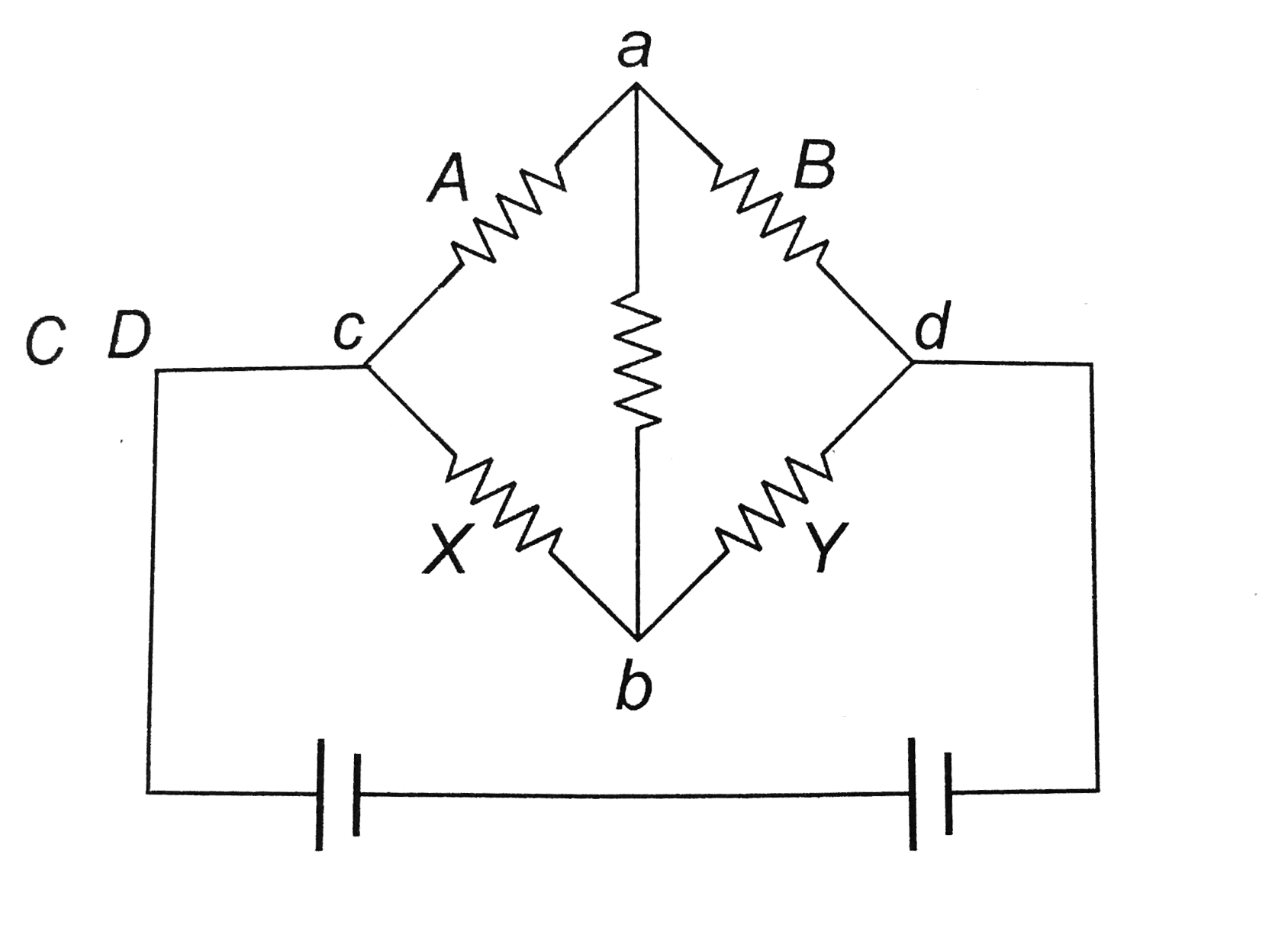
View SolutionThe firgure shows a circuit diagram of a 'Wheatstone Bridge' to measure the resistance `G` of the galvanometer The relation `(P)/(Q) = (R )/(G)` will be satisfied only when

View SolutionIn the circuit shown, a meter bridge is in its balanced state. The meter bridge wire has a resistance `.1 ohm//cm`. The value of unknown resistance `X` and the current drawn from the battery of negligible resistance is
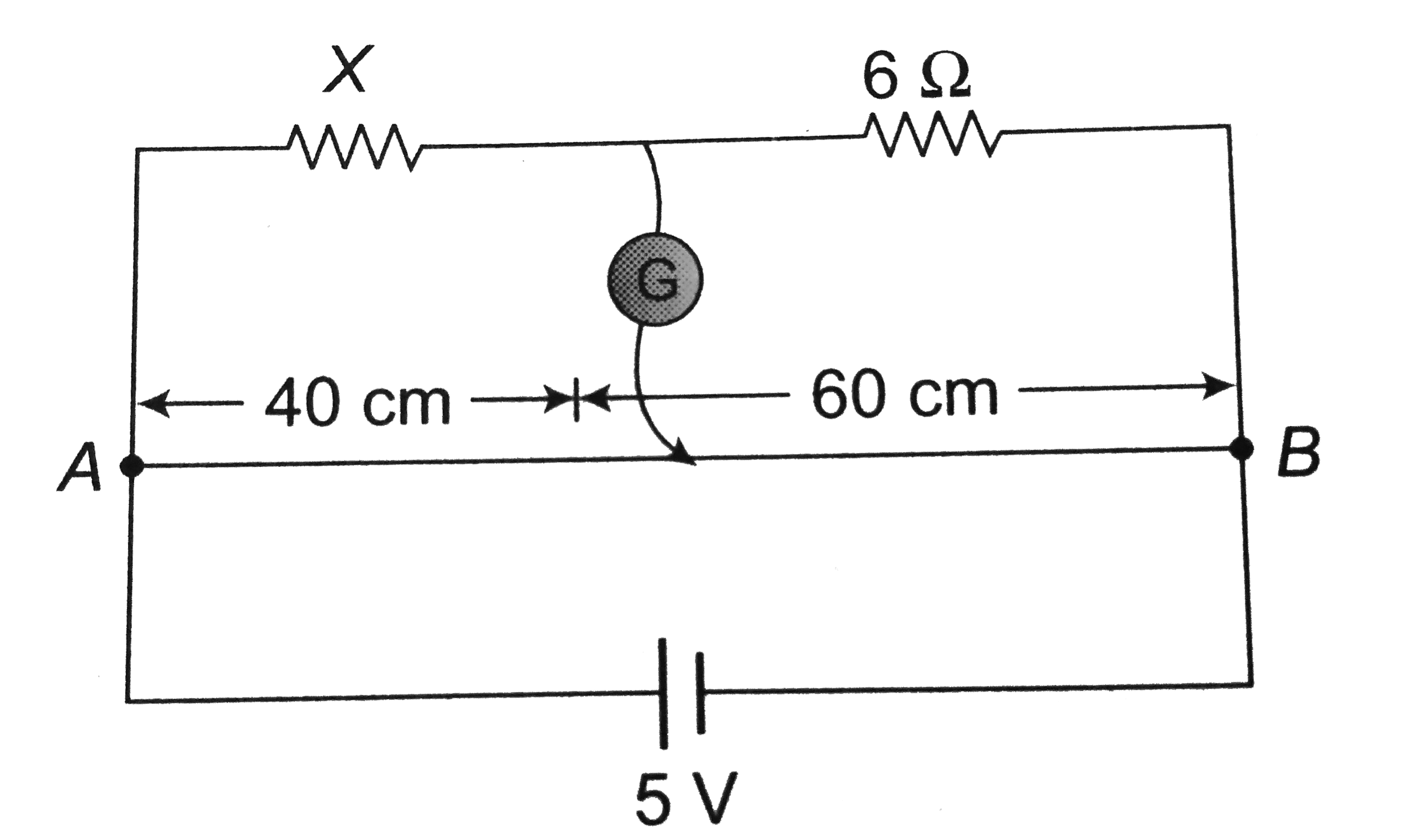
View SolutionIn a meter bridge experiment, the null point is obtained at `20 cm`from one end of the wire when resistance `X` is balanced against another resistance `Y`. If `X lt Y`, then where will be the new position of the null point from the same end, if one decides to balanced a resistance of `4X` against `Y`?
View SolutionTwo resistances are connected in the two gaps of a meter bridge. The balance point is `20 cm` from the zero end. When a resistance `15 Omega` is connected in series with the smaller of two resistance, the null point+ shifts to `40 cm`. The smaller of the two resistance has the value.
View SolutionIn a practical wheat stone bridge circuit as shown, when one more resistance of `100 Omega` is connected in parallel with unknown resistance 'x', then ratio `l_1//l_2` become '2'`l_1` is balance length , AB is a uniform wire. Then value of 'x' must be :
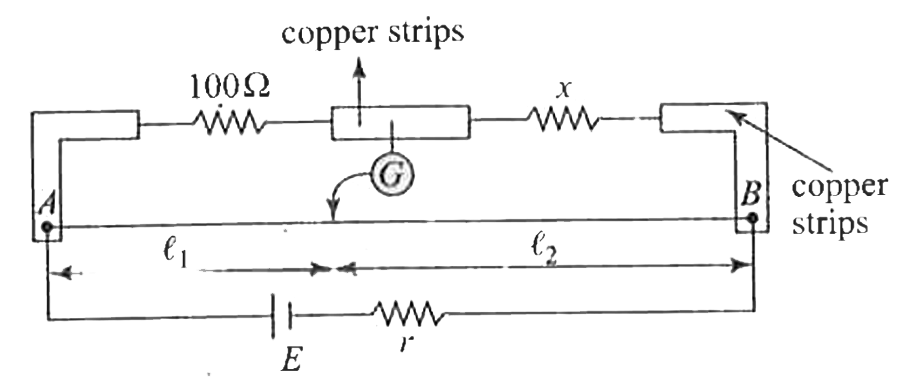
View SolutionA resistance R is to be measured using a meter bridge. Student chooses the standared resistance S to be `100 Omega`. He finds the null point at `l_(1)=2.9cm`. He is told to attempt to improve the accuracy. Which of the folllowing is a useful way?
View Solution`R_1, R_2, R_3` are different values of `R, A, B` and `C` are the null points obtained corresponding to `R_1, R_2` and `R_3` respectively. For which resistor, the value of X will be the most accurate and why?
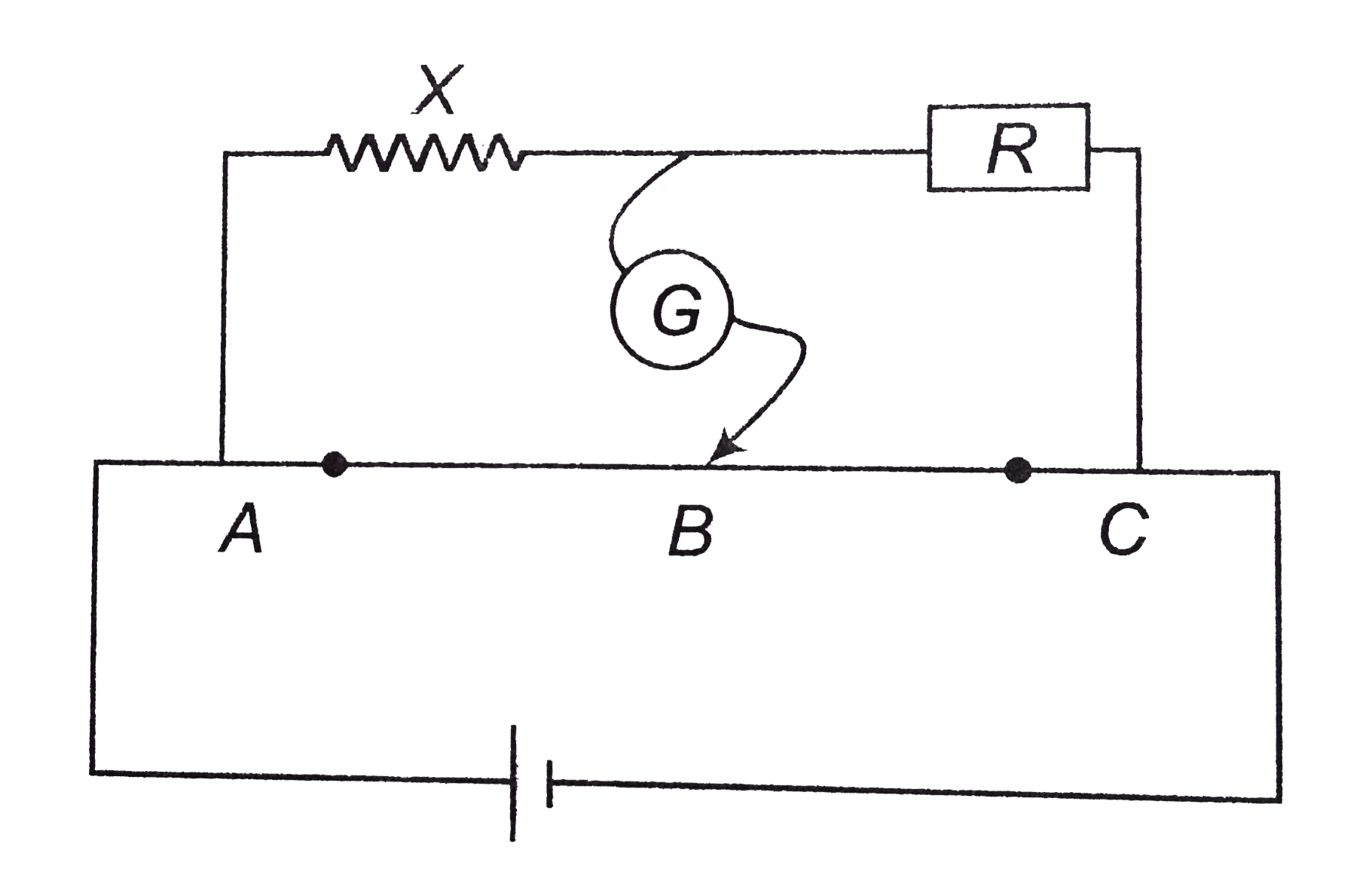
View Solution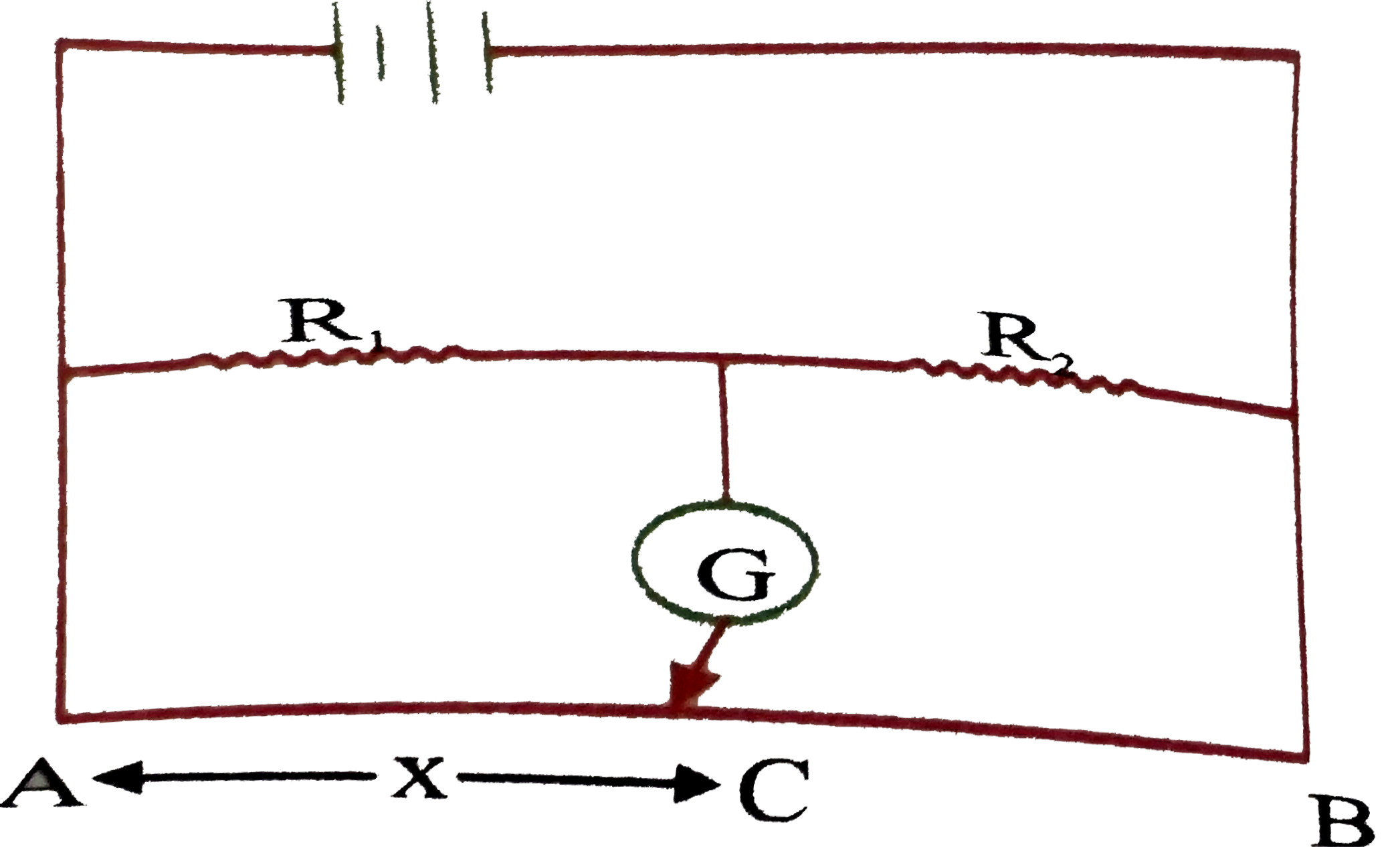
In the shown arrangement of the experiment of the meter bridge if AC corresponding to null deflection of galvanometer is x, what would be its value if the radius of the wire AB is doubled?
View SolutionIn the circuit `P != R, ` the reading of the galvanometer is same with switch S open or closed. Then
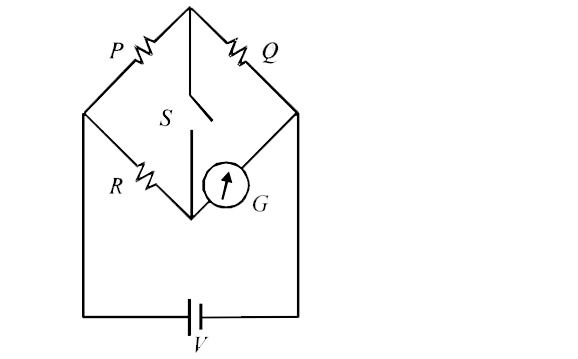
View Solution
Single Correct questions and complete solutions for chapter ELECTRICAL MEASURING INSTRUMENTS of CENGAGE PHYSICS (HINGLISH) of Class 12